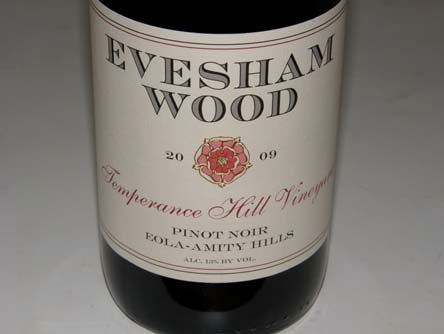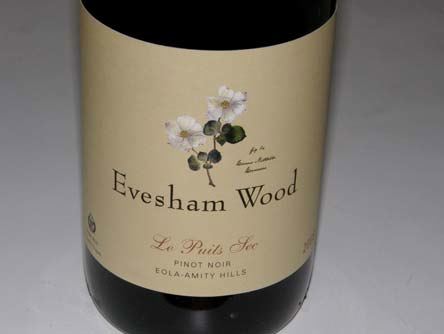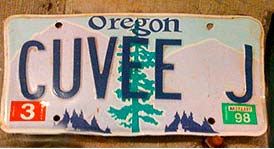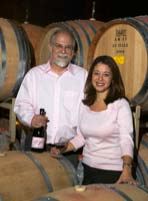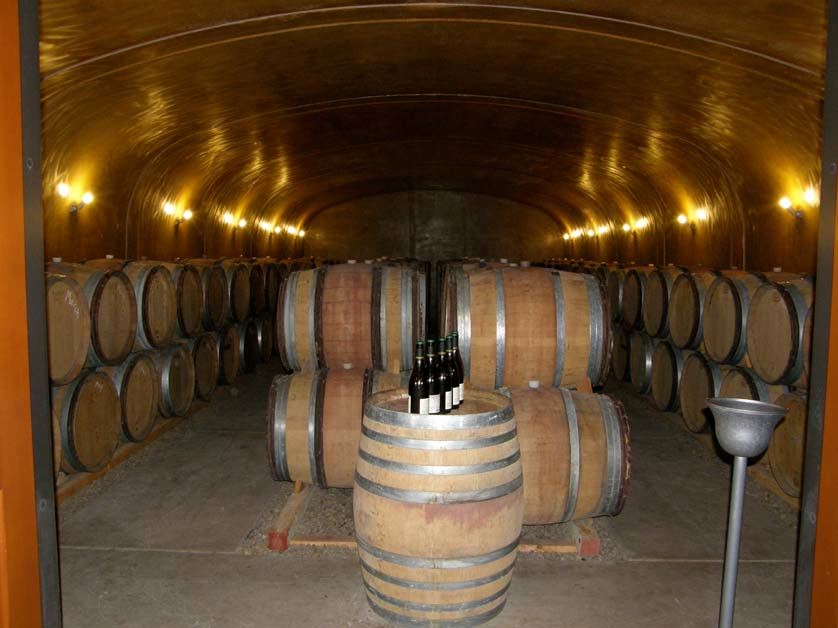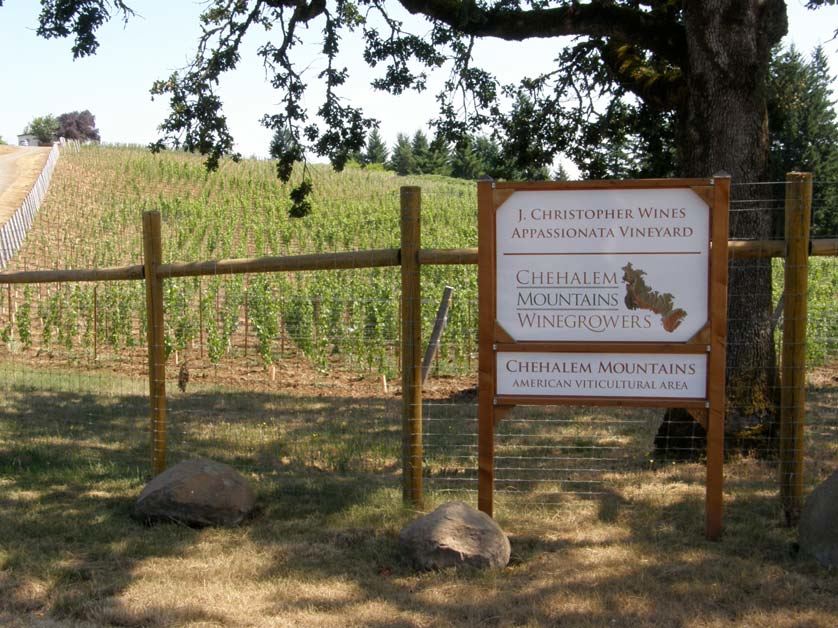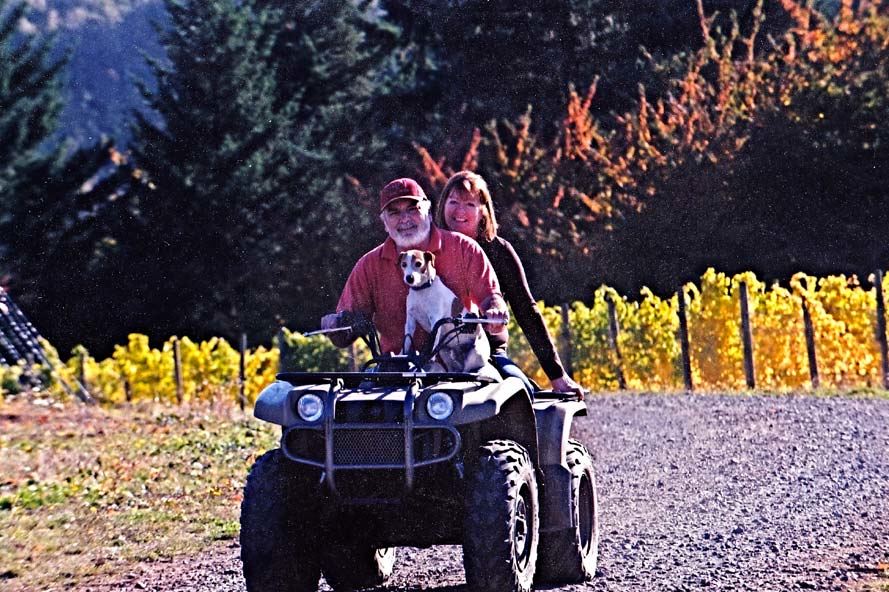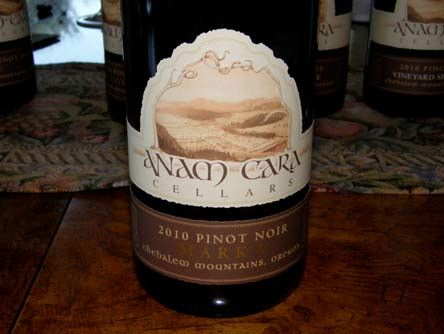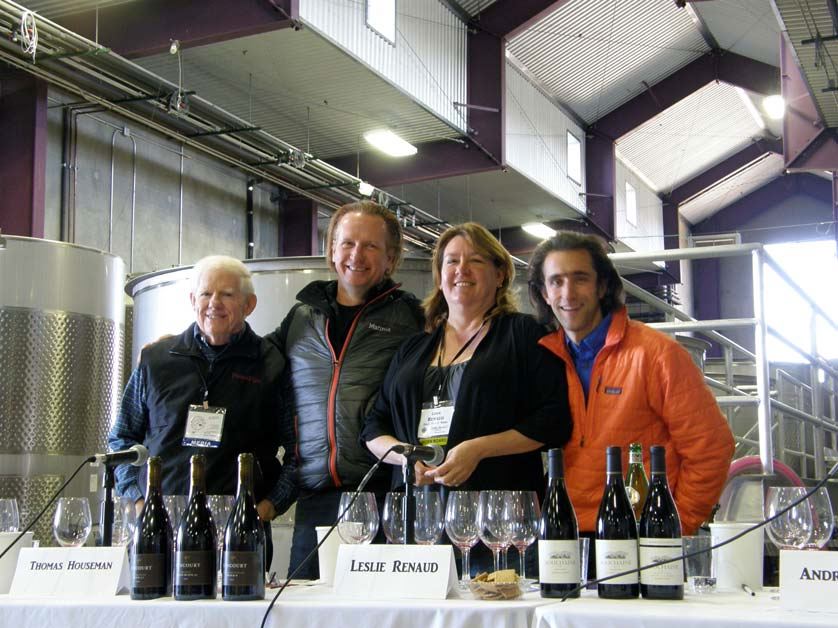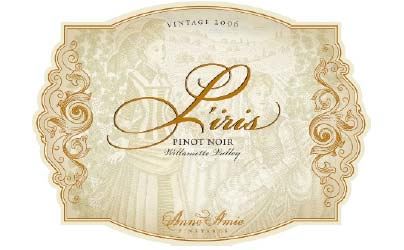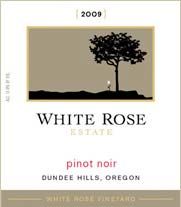PinotFile: 9.11 September 11, 2012
|
2010 Oregon Pinot Noir: Wines Endowed with Romance, Depth & Ostentation
Now the good news. The 2010 vintage turned out to be one of the best vintages for Pinot Noir ever in the Willamette Valley, rivaling the greatest years of 1993, 1999 and 2002: “Ten is Zen.” The extended hang times and low yields led to wines displaying lush, ripe fruit with great depth of flavor at lower alcohol levels with perfectly matched acidity and modest tannins. Sure, there are exceptions and some wines are lacking in color and flavor intensity attributable to under ripe fruit, but the majority are clearly ostentatious. The 2010 Pinot Noirs are also very user friendly upon release, and in keeping with previous cooler vintages in Oregon, they should age extremely well. Perhaps Maggie Harrison, winemaker and one of the proprietors of Antica Terra, summarized the 2010 vintage best. “As we sat across from our accountant, a 30-year veteran of the industry and self-proclaimed Oregon wine visionary, he leaned comfortably back in his chair, cracked his knuckles, and with almost a gleam in his eye predicted 2010 would be a “bloodbath” for the Oregon wine industry. This moment and its surreal, cinematic quality captures the apocalyptic mood that attended our experience with the 2010 vintage. Yields were very low. Poor fruit set, combined with draconian thinning and the tariff exacted by birds, left us with less than half the wine to offer compared with previous years. But the wine that we have is exquisite. The 2010 wines share the concentration of 2008, but are slightly less tannic and about a half-degree lower in alcohol. This slight dip in alcohol translates into wines of perfect pitch that resonate more clearly than anything we have produced before. The experience of making these wines has shown us the beauty that can emerge when the weather pushes us and our vines further than we thought possible.” You might ask why I omitted 2008 in pointing out the greatest vintages in Oregon. The 2008 vintage offered the perfect growing season in the Willamette Valley, and many consider this vintage the best overall ever for Oregon. The wines do have impeccable balance, great structure and impressive age ability. However, they were not easily approachable on release, and even now, remain closed down and monolithic. They have softened, but still not expressive aromatically. Only time will tell. A number of 2010 vintage Willamette Valley Pinot Noirs were favorably reviewed in May 2012 in the PinotFile (www.princeofpinot.com/article/1217/). Since then, I have had the opportunity to sample a number of other 2010 Willamette Valley Pinot Noirs and my excitement over this vintage has not wavered. After attending the International Pinot Noir Celebration in July 2012, I spent a week in the Willamette Valley visiting wineries and tasting 2010 Pinot Noirs from bottle. In addition I tasted barrel samples of the equally promising 2011 vintage. My full report follows.
2010 Pinots Tasted in the Willamette
Dick Shea farms 136.5 acres of Pinot Noir and 3.5 acres of Chardonnay in the Yamhill-Carlton District. Grapes are sold to 22 other notable producers of Pinot Noir in the Willamette Valley ( Antica Terra, Beaux Frères, Bergström, Boedecker, Elk Cove, J.K. Carrier, Ken Wright Cellars, Panther Creek Cellars, Penner-Ash, Raptor Ridge, Rex Hill, Stephen Goff, Stevenson Barrie Cellars, St. Innocent, Wildair, and Winderlea) and California (Ancien, Auteur, Roessler, and Sonoria). 25% of the vineyard production is held back for Shea’s own Shea Wine Cellars label (about 5,500 cases). Pinot Noir clones planted at Shea Vineyard include Pommard, Wädenswil, and Dijon 114, 115, 777. Soils are Willakenzie, well-drained and shallow over fractured siltstone at 450 feet elevation. The most recent winemaker for Shea Wine Cellars, Drew Voit, left in 2012 to pursue his own label and other projects. He was replaced by Blair Trathen, a New Zealander who has crafted wine in Oregon for ten vintages, most recently at Rex Hill. He is currently putting the finishing touches on the 2011 wines. The wines from Shea Wine Cellars are sold primarily through a mailing list (www.sheawinecellars.com) with limited retail distribution. The winery is not open to the public. The nomenclature of the Shea Wine Cellars Pinot Noirs has varied through the years, but in 2010, except for the Estate and Homer, all wines are block-designated. When I visited in July, the Estate, Block 31 and Homer had been released. I tasted these 2010 wines from bottle and 2011 wines from blending tanks briefly at the winery and was impressed. Dick was to send me the lineup of 2010 wines to review formerly but the hot weather in Southern California has not permitted him to ship the wines to me. When weather permits, I will receive the wines and fill in the reviews of the wines listed.
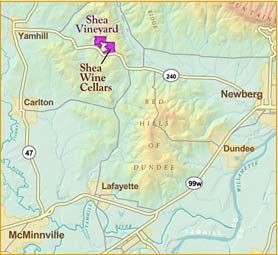 2010 Shea Wine Cellars Shea Vineyard Estate Willamette Valley Pinot Noir 13.2% alc., 3,475 cases, $40. All clones planted at Shea Vineyard. Aged in 47% new French oak. 2010 Shea Wine Cellars Shea Vineyard Block 7 Willamette Valley Pinot Noir 13.5% alc., 300 cases, $56. Wädenswil clone. Aged in 64% new French oak. 2010 Shea Wine Cellars Shea Vineyard Block 23 Willamette Valley Pinot Noir 13.5% alc., 265 cases, $56. Pommard clone. Aged in 80% new French oak. 2010 Shea Wine Cellars Shea Vineyard Block 31 Willamette Valley Pinot Noir 13.6% alc., 240 cases, $56. 67% Pommard, 33% Wädenswil. Aged in 60% new French oak. 2010 Shea Wine Cellars Shea Vineyard Block 33 Willamette Valley Pinot Noir 13.5% alc., 250 cases, $56. Dijon 777. Aged in 60% new French oak. 2010 Shea Wine Cellars Shea Vineyard Homer Willamette Valley Pinot Noir 13.5% alc., 450 cases, $82. 56% Wädenswil, 31% Dijon 777, 13% Pommard. Aged in 81% new French oak. A blend of the best barrels in the cellar and always the biggest, most structured wine in the lineup, needing several years to reach a peak drinking window. 2010 Shea Wine Cellars Shea Vineyard Willamette Valley Chardonnay 13.5% alc., 700 cases, $30. Dijon 95, 76. 100% MLF. Aged in 18% new French oak and 6% stainless drums.
Lenné Estate: Nose for Pinot Located a few miles west of Shea Vineyard on a ridge top, Lenné (“Lenay”) Estate is farmed by Steve Lutz, who also shares the winemaking duties with noted Oregon vintner, David O’Reilly. The initial vines went into the ground in 2001, planted on low vigor sedimentary and volcanic soils. Today, the vineyard consists of 20.9 acres of Pinot Noir. Beginning in 2007, the wines from Lenné Estate really showed promise, and in 2010, Steve hit the jackpot. The entire lineup is really top notch. The entry-level wine, LeNez, is solid, and the Lenné Estate wines, which represent the best barrels from the vineyard in each vintage, are all very special. The wines were previously reviewed in the PinotFile in May 2012. New oak treatment varies between 35% and 50%. Steve believes that the wines will be at their best 7 to 10 years from the vintage date. The wines are sold through a mailing list, the winery’s website (www.lenneestate.com) and the tasting room at 18760 NE Laughlin Road in Yamhill (open weekends or by appointment). Besides the wines tasted, the following are also available: 2010 LeNez Pinot Noir (more fruit forward and most approachable, $30) and 2010 Lenné Estate Kill Hill Pinot Noir (best barrels from the steepest part of the vineyard which has the poorest soil, named as a tribute to the many vines that died in establishing this part of the vineyard originally, $55).
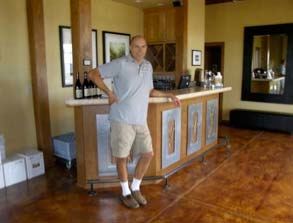
2011 Le Nez Willamette Valley Pinot Noir Blanc 13.0% alc., 30 cases. In 2011, less ripe fruit was used to produce this wine and a rosé. Soft release (sold to wine club members and through tasting room). Aged in neutral oak, no MLF. · Pleasant aromas of fresh apple, tropical fruits and nuts. Bright and crisp on the palate with a good cut of acidity on the apple-driven finish. Picks up fruit intensity over time in the glass. Good.
2010 Lenné Estate Eleanor’s 114 Yamhill-Carlton District Pinot Noir 14.0% alc., 49 cases, $55. Named after Steve Lutz’s mother and represents the best barrels from Dijon 114 block. · Very expressive aromatics, drawing the drinker into the glass. Aromas of fresh cherries, spice, leather and toast. Good depth on the palate, with a charming elegance, offering flavors of brandied cherries, spice and sandalwood, supported by soft tannins, ending with a pleasing lift of acidity. Very good.
2010 Lenné Estate Estate Yamhill-Carlton District Pinot Noir 14.0% alc., $45. Primarily Pommard and Dijon 115. · Enticing scent of fresh strawberries and chocolate-covered cherries. Elegant and soft on the palate, with medium weight flavors of well-spiced cherries and a hint of dark chocolate in the background. Picks up interest and intensity over time in the glass. Very good.
2010 Lenné Estate Jill’s 115 Yamhill-Carlton District Pinot Noir 14.0% alc., 125 cases, $55. Named after Steve Lutz’s mother-in-law. The best barrels from 115 block. · Shy aromas of black cherries, black raspberries, and dark chocolate. A cherry bombast on the palate, with a subtle backing of oak. Admirable finesse, yet enough structure to last. Gorgeous.
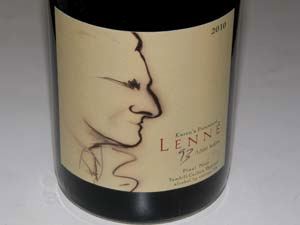 2010 Lenné Estate Karen’s Pommard Yamhill-Carlton District Pinot Noir 14.0% alc., 125 cases, $55. The best barrels from the vineyard’s two Pommard blocks and is named after owner Steve Lutz’s wife, Karen. · The aromatics are stunning, with high brow aromas of cherries, mocha and sandalwood. Softly textured with supple tannins, yet offering a luscious fruit ensemble of cherries, black raspberries and currants accented by oak spice. Great.
2008 Lenné Estate Estate Yamhill-Carlton District Pinot Noir 14.0% alc., $45. A barrel selection of the finest barrels from the best parts of the vineyard. · Opens reluctantly, with shy aromas of red cherries and mint. Intense and dense cherry core with plenty of tannic backbone and eye popping length on the dry finish. Years away from prime time. Very good.
The Eyrie Vineyards: Sacred Ground for Pinot Noir The Eyrie Vineyards winery and tasting room in McMinnville is a time capsule of the history of Willamette Valley Pinot Noir. Jason Lett, who took over the legacy of this iconic winery when his father, David Lett, passed away in October 2008, has preserved its identity and the character of David’s wines. David Lett arrived in the Willamette Valley in 1965, established a nursery planting of Pinot Noir in Corvallis, and in 1966, spent his honeymoon with his new spouse Diana planting the first five acres of vines that included Pinot Noir and Pinot Gris. The Letts named their vineyard Eyrie (“Eye-ree”), an old word meaning “hawk’s nest,” when a pair of red-tailed hawks built a nest in the fir trees above the first vineyard that the newly married couple were planting. There are still eyries at Eyrie with hawks nesting in the trees above the vineyard each year. Lett produced his first Pinot Noir in 1970, but because of its light color, he labeled it “Oregon Spring Wine.” In 1979, Robert Drouhin of the famed Domaine Drouhin in Burgundy, set up a blind tasting of French burgundies versus American Pinot Noirs. At this now famous tasting hosted by the French food and wine magazine, Gault- Mileu, and held in Paris, a 1959 Domaine Drouhin Chambolle-Musigny came in first, but David Lett’s 1975 The Eyrie Vineyards South Block Reserve Pinot Noir took second ahead of a number of prestigious French wines. The Eyrie Vineyard South Block Reserve was made solely from the Wädenswil clone. This was a seminal event for the Oregon wine industry and persuaded Robert Drouhin to establish his own vineyard and winery in the Dundee Hills in 1987. The published results of this Gault-Mileu tasting are proudly displayed on The Eyrie Vineyards tasting room wall:
 The room where David Lett made his first wines is but the size of a small two-car garage:
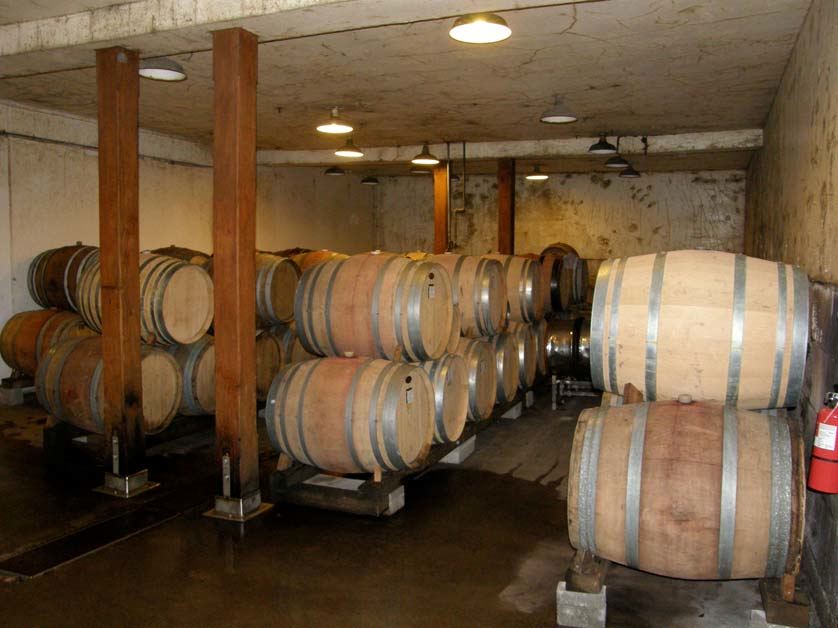 David’s original oak barrels, dating to 1970, are still in use in the winery, refurbished by a local cooper as needed:
 I tasted a number of wines with Jason, some of which are quite precious, and they are dispensed through an argon preservative system and sold to visitors by the glass. Jason has taken the time to examine all the library Pinot Noir and Chardonnay wines, discard the oxidized or otherwise unacceptable bottles, and re-cork them. In recent years he has organized significant retrospective tastings of The Eyrie Vineyards Pinot Noir (2008), Chardonnay (2009, www.princeofpinot.com/article/726/) and South Block Reserve Pinot Noir (2011).
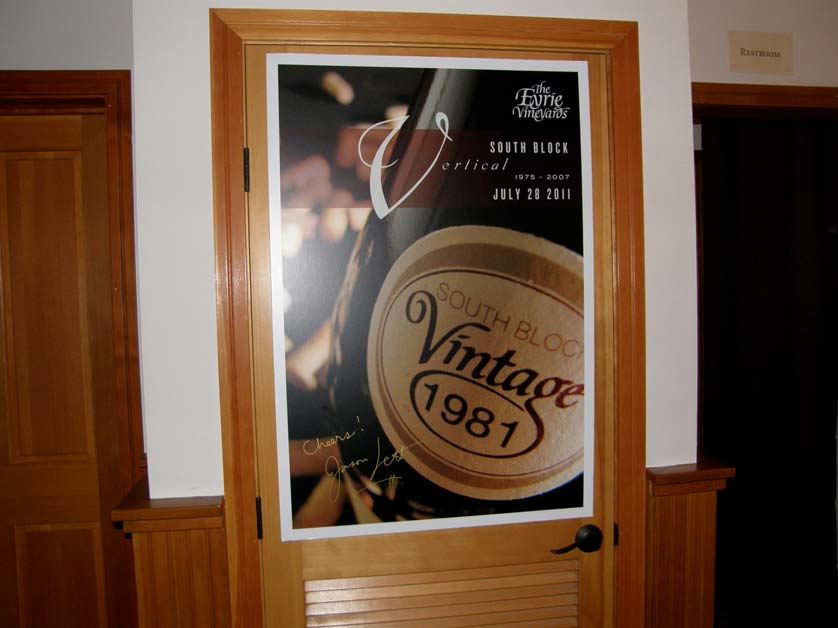 Pinot Noir estate vines at The Eyrie Vineyards, planted between 1965 and 1989, average 30 years in age, are 100% own-rooted, organically farmed, and 100% non-irrigated: unequaled in Oregon. The Eyrie Vineyard was planted between 1966 and 1974 and consists of 17.4 acres. Wine contributions: Pinot Noir Original Vines Reserve, Chardonnay Original Vines Reserve, Chardonnay Estate, Pinot Gris Estate, Melon de Bourgogne, Muscat Ottonel and Pinot Meunier. The Daphne Vineyard was planted between 1974 and 1984 and consists of 12.7 acres. At almost 900 feet, Daphne is one of the oldest and highest elevation plantings in the Dundee Hills. Wine contributions: Pinot Gris Estate, Pinot Noir Estate, Pinot Meunier, and Pinot Noir Daphne Reserve. The Rolling Green Farm is 6.0 acres planted in 1988. It includes 18 acres of prime unplanted ground that will be developed over the next decade. Wine contributions: Pinot Noir Estate, Pinot Gris Estate. The Sisters Vineyard was planted in 1989 and covers 15.3 acres. The vineyard was named after the three Pinot sisters: Pinot Noir, Pinot Gris and Pinot Blanc. There are also 15 acres of hazelnuts planted at the site. Wine contributions: Pinot Noir Estate, Pinot Blanc Estate, and Pinot Gris Estate. The Eyrie Vineyards tasting room is open Weds-Sunday, 12:00-5:00, at 935 NE 10th Avenue @ Alpine in McMinnville. Cost of tasting is $5 per person which is refundable with the purchase of two bottles of wine (library wines are an added cost). The Eyrie Vineyards is a required pilgrimage for any serious pinotphile visiting the Willamette Valley. Visit the website at www.eyrievineyards.com for more details.
2010 The Eyrie Vineyards Estate Pinot Blanc 13.5% alc., $16.75. · A delicate wine with subtle aromas and flavors of apple, herbs, and nuts, soft and slightly creamy on the palate, finishing fresh and lively with a slight spritz. Good.
2010 The Eyrie Vineyards Original Vines Reserve Chardonnay 13.5% alc., $45. A barrel selection. · Shy but pleasing aromas of fresh lemons and fig. Fresh and minerally, offering flavors of fresh green apple, lemon and hazelnut, backed by a good cut of acidity, finishing with a lemon-driven flourish. A connoisseur’s wine that will challenge the senses. Enjoyable now, but will age easily ten years. Very good.
2010 The Eyrie Vineyards Pinot Meunier 12.5% alc., $35. An unusual varietal bottling for Oregon from 1.5 acres of the original vineyard plantings. Label is written in David’s hand. Very little production and sells out quickly. · Aromas of red berries and cherries with a smoky accent. Light and delicate with flavors of red fruits, tobacco and herbs, lifted with bright acidity. Not to my taste, but extremely popular with consumers. Decent.
2010 The Eyrie Vineyards Estate Pinot Noir 13.5% alc., $36. A blend of grapes from all estate vineyards. · Light reddish-purple color in the glass. Aromas of herbs and oak dominate the fruit at present. Crisp and juicy on the palate with a delicate core of tasty red cherry and strawberry fruit, finishing with a savory herbal tone. Supple tannins make for easy drinking now, but this wine will benefit from a few years in bottle. Very good.
2010 The Eyrie Vineyards Estate Pinot Noir 13.5% alc., $36. A blend of grapes from all estate vineyards. · Light reddish-purple color in the glass. Aromas of herbs and oak dominate the fruit at present. Crisp and juicy on the palate with a delicate core of tasty red cherry and strawberry fruit, finishing with a savory herbal tone. Supple tannins make for easy drinking now, but this wine will benefit from a few years in bottle. Very good.
2009 The Eyrie Vineyards Daphne Vineyard Dundee Hills Willamette Valley Pinot Noir 13.5% alc., $75. Originally named Stonehedge, the Daphne Vineyard is located above the original plantings about 400 feet higher in elevation and is a marginal site. Planted in 1979 and 1980, it has 13 acres of Pinot Gris, Pinot Meunier and Pinot Noir (1.5 acres of Wädenswil and Pommard). David Lett first made a Daphne Vineyard Pinot Noir in 2001 but didn’t particularly like it, and didn’t release it until years later when it was sold to wine club members. Jason found an old stash in the winery’s warehouse. It was produced in 2008 and 2009, but not in 2010 or 2011 (acidity too high). · Moderate reddish-purple color in the glass. A very generous wine with vivid aromas of red berries and rose garden. More body and intensity than typical for Eyrie Pinot Noirs, featuring copious dark red berry and cherry fruit with a subtle note of oak, finishing dry with impressive length and show of black raspberry flavor. A special wine made in the Eyrie style but amplified, changing with every sip and showing impeccable balance. Flat-out great.
13.5% alc., 700 cases, $47.25. A cuvée of grapes from the Dundee Hills AVA and Eola-Amity Hills AVA (Cattrall Brothers Vineyard). All grapes are the product of organic viticulture and ownrooted Pommard and Wädenswil clones. A New World style of Pinot Noir first crafted by Jason in 2002. · Fragrant aromas of ripe dark cherries and berries. Moderately rich array of dark red and black fruits with toothsticking tannins. A little heat shows up on the nose and finish. Decent.
1983 The Eyrie Vineyards South Block Reserve Pinot Noir Light rose color in the glass. Vibrant aromas of cherries, rose petals, fennel and leather glove. Very expressive nose for such an old wine. Aged flavors of brandied cherries, spice, and tea, finishing with a subtle herbal note. Impressive longevity.
1983 The Eyrie Vineyards Estate Reserve Chardonnay Attractive golden color in the glass. Aromas of sherry and roasted nuts. Surprisingly giving, offering plentiful flavors of white peach, baked pear, créme brûlée and hazelnuts. A creamy texture adds to the appeal. A sensual wine with incredible longevity.
1989 The Eyrie Vineyards Estate Pinot Gris This might have been the most amazing wine I tasted this day. I have never smelled anything like this wine with its exotic aromas that included cooked banana, roasted nuts, and caramel. Soft, creamy and luscious on the palate, tasting of the best banana split you have ever had, this wine wove together a complex flavor experience that was impossible to adequately describe. This one wine is worth a visit to The Eyrie Vineyards tasting room. Unbelievable.
Privé Vineyard: French Spoken Here I recently wrote extensively about Privé Vineyard and included a vertical tasting of the winery’s Pinot Noirs (www.princeofpinot.com/article/1216/). Mark and Tina Hammond hand craft a small amount of Pinot Noir from two acres of vines planted on their estate in the Chehalem Mountains AVA. He manages the vineyards and she makes the wines. They bottle three wines: “le sud” from the southern 1 acre, “le nord” from the northern 1 acre, and “joie de vivre”, a reserve crafted in half-barrel quantities and presented in an etched bottle. Demand is extremely high and the mailing list has been filled for some time now.
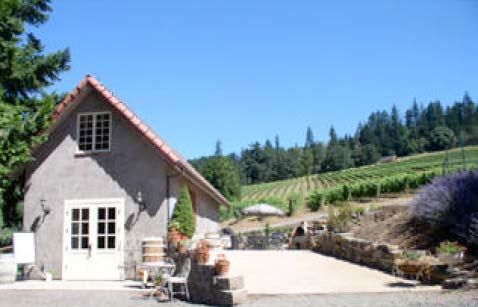 A Willamette Valley blend was added in 2009 as a forward-drinking Pinot Noir that could be offered to visitors to the winery. The blend is a notch up in ripeness compared to the estate wines and is sourced from vineyards that meet the Hammonds’ high standards. It has become very popular and the winery sells more of it than le sud and le nord combined. The Hammonds have made significant changes in their farming beginning with the 2010 vintage and this has led to wines with greater fruit purity. The vineyards underwent a devigorization by abandoning the use of nitrogen fertilizer, letting weeds grow between rows, changing the cane management, and instituting more rigorous dropping of fruit especially in cool vintages. When I visited this July, I was led into the expanded winery (it is still very small) and sampled the 2011 Pinot Noirs from barrel. In 2010, 75% of the crop was lost and in 2011, yields were half of a “normal” crop, but still considerably more than in 2010. Both le sud and le nord produced 175 cases in 2011. The wines were picked at 23º and 23.5º Brix. The le nord was flush with pie cherry, spice and pepper flavors. The le sud offered darker fruits (blue and purple) and less spice. Both wines were crisp and juicy and full of life. Tina is extremely pleased with the 2011 vintage. Tina not longer crafts a Cabernet Sauvignon, concentrating instead on Syrah crafted in a Pinot Noir style. She sources grapes from two vineyards, one in Oregon and one in Washington. Tasted out of barrel, the Syrah was very appealing with a restrained and elegant quality uncommon for Syrah. The Hammonds have carved out a little niche of heaven in the Chehalem Mountains. Visits and tastings are by appointment (503-554-0464). The website is www.privevineyard.com.
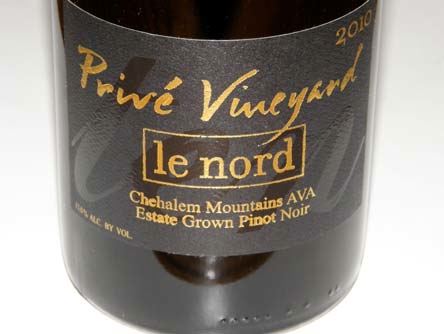
Bethel Heights: Modern Family The Casteel brothers were in academics at the University of Michigan teaching English when they visited Oregon and fell in love with it. They gave up their careers and studied viticulture at the University of California at Davis, then moved to Oregon for good in 1977. With partners Pat Dudley and Marilyn Webb, they acquired 75 acres from Vic Winquist (who was to develop many nearby properties including Seven Springs, Elton, Temperance Hill, Zenith, and Canary Hill vineyards) in what is now the Eola-Amity Hills AVA. The property had 14 acres of newly planted vines in the ground and the Casteels added additional vines between 1977 and 1979, making it one of the first vineyards in the Eola-Amity Hills. The first wines were produced in 1984.
The Eola-Amity Hills is located northwest of Salem, Oregon and consists of 38,000 acres. There are more than 1,500 acres planted to wine grapes, with over 75 vineyards and 30 commercial wineries. The name “Eola” was adapted from the word, “Aeolus,” a minor deity of the ancient Greeks who was in charge of the winds. The written history of the origins of the name are sparse, but it is thought that the name was given by Lindsay Robbins, who observed the predictable afternoon marine breezes that enter the Willamette Valley from the Pacific Ocean through the Van Duzer Pass, the lowest point in Oregon's Coastal Range. Robbins was reminded of a wind harp, appropriately called the Aeolian harp. The northern extension of the Eola Hills became known as the Amity Hills. Since the Eola Hills and Amity Hills are really one hill connected by a chain of smaller hills, the name Eola-Amity Hills was proposed for the AVA. The AVA encompasses vineyards and wineries in both Polk and Yamhill counties of Oregon and was approved in 2006. The first planting of Vitus vinifera in the Eola-Amity Hills was in 1971 by Jerry and Anne Preston, who sold their Amity Vineyards to Myron Redford in 1974.
Ted managed the vineyards and Terry made the wines for the first 30 years. Pat and Marilyn directed the marketing program and handled the business management. Currently, the second generation has taken over the family business. Terry and Marilyn’s sons, Ben and Jon Casteel, and Ted and Pat’s daughters, Mimi and Jessie Casteel, all grew up at Bethel Heights. Since 2006, Ben has been the winemaker, and Mimi the general manager and viticulturist. The quality of the wines continues to impress. Mimi will head the Board of Directors for next year’s International Pinot Noir Celebration, July 26-28, 2013 (pictured below at this year’s event).
 Bethel Heights now has 96 acres of estate vineyards, all certified sustainable since 1999 by both LIVE and Salmon Safe: Bethel Heights Vineyard is 49 acres (37 Pinot Noir, 5 Chardonnay, 4 Pinot Blanc, 3 Pinot Gris with 2 acres of Pinot Noir Gamay and 2 acres of Wädenswil dating to 1977 and 3.3 acres of Flat Block Pommard Pinot Noir and 6 acres of Southeast Block Pommard, both dating to 1979), Justice Vineyard is 22 acres (17 Pinot Noir, 5 Chardonnay), and Ingram Lane Vineyard is 25 acres (20 Pinot Noir, 2.5 Chardonnay, 2.5 Riesling). Multiple Pinot Noir clones are represented (Pommard, Wädenswil, and Dijon 114, 115, and 777). 77% of the estate vineyard plantings are Pinot Noir, and this is clearly the winery’s focus. Several Pinot Noirs are offered including a Willamette Valley blend intended primarily for restaurant programs, the signature “black label” Estate Grown Pinot Noir (a blend from all sections of the estate vineyards), the Casteel Reserve (a best-barrel blend from several different sites, produced since 2005), and various block-designated and vineyard-designated wines. Total production is 13,000 cases of all varietals.
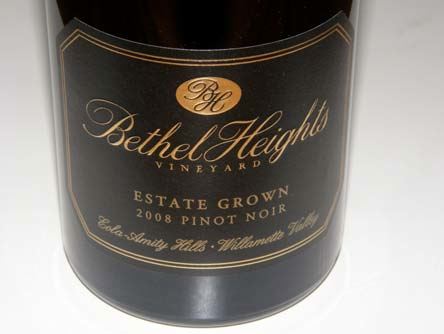 Visitors are welcome to the vineyard and tasting room Tuesday-Sunday 11:00-5:00 February-November, Saturday-Sunday 11:00-5:00 in December, and by appointment in January. The tasting rooms is quite charming with expansive views of the Bethel Heights Vineyard and plenty of spots to picnic and enjoy the wines both inside and outdoors. The entire staff here is particularly warm and welcoming. For me, this is the quintessential Willamette Valley winery. The website is www.bethelheights.com. I tasted through the lineup of 2010 Bethel Heights Pinot Noirs at a seated tasting with winemaker Ben Casteel. The wines confirmed my joy with the 2010 vintage and really impressed with their hi-tone aromatics, fruit purity, and balance. Ben told me the 2011 vintage Pinot Noirs are similar, showing power at lower alcohols.
2010 Bethel Heights Willamette Valley Pinot Noir 12.8% alc., 300 cases, $28, screw cap. All grapes sourced from Eola-Amity Hills. Aged in 30% new French oak. · Moderately light reddish-purple color in the glass. Shy nose with delicate aromas of red cherries and raspberries with a hint of oak. Light in weight, featuring red fruits with an underpinning of citrus and oak, backed by mild tannins and bright acidity, finishing with tart cherry and herb flavors. Decent.
2010 Bethel Heights Carter Vineyard Eola-Amity Hills Pinot Noir 12.4% alc., 200 cases, $50. Pommard clone planted in 1982. · Enticing aromas of cherries, fraise du bois, forest floor, stem and sandalwood. Moderately light but flavorful, with a core of juicy, dark red cherries. Good structural integrity, polished tannins, finishing dry and savory. Good.
2010 Bethel Heights Black Label Estate Grown Eola-Amity Hills Pinot Noir 12.5% alc., 3,000 cases, $32, screw cap. Composed primarily of older estate vineyard blocks. Aged in 30% new French oak. · Moderately deep reddish-purple color in the glass. Penetrating aromas of black cherries, dark red berries, earth and complimentary oak, that really draw you into the glass. Crisp, with a core of earth-kissed dark red stone fruits and berries, wrapped in supple tannins, offering a good cut of acidity, finishing with some aromatic persistence. A solid value priced wine that will work nicely at the dinner table. Good (+).
2010 Bethel Heights Justice Vineyard Estate Grown Eola-Amity Hills Pinot Noir 12.7% alc., 150 cases, $50. Primarily Pommard and Dijon clones. · Moderate reddish-purple color in the glass. Pleasing array of dark red cherry and berry aromas with a hint of oak vanillin. A step up in mid palate impression, with moderately rich and ripe cherry flavors that are expansive and long on the generous finish. Well-integrated oak. Needs more time to fully integrate the tannins but will be worth the wait. Very good.
2010 Bethel Heights West Block Estate Grown Eola-Amity Hills Pinot Noir 12.8% alc., 200 cases, $50. 1977 Wädenswil planting. · Moderate reddish-purple hue in the glass. Powerful aromatics filling the glass with the scents of fresh dark berry tart and black cherry cola. Discreetly rich core of marionberry, blackberry and plum fruit, backed by ripe tannins and brought into a juicy focus by lively acidity. A complete wine with a very long, richly fruited and refreshing finish. Classy juice. Very good (+).
2010 Bethel Heights Flat Block Estate Grown Eola-Amity Hills Pinot Noir 12.8% alc., $58. Pommard clone planted in 1979. · Medium garnet color with slight haze (unfiltered) in the glass. Very expressive aromatics that are captivating. Perfume of oak-kissed black cherries and berry jam on toast. A cherry bombast supported by perfectly matched tannins and acidity, seductively endowed with a very soft mouth feel, finishing like a three hour movie you don’t want to end. An exceptional wine that will please any Pinot connoisseur. Very good (+).
2010 Bethel Heights Southeast Block Estate Grown Eola-Amity Hills Pinot Noir 12.9% alc., 200 cases, $50. Pommard clone planted in 1979. Adjacent Flat Block but with deeper soils. · Moderate garnet color in the glass. The bright aromas jump out of the glass right after pouring exhibiting a lovely perfume of black cherries and spice. Darker fruited with more earthiness, evident oak and astringent tannins than the Flat Block. Finishes very long with a dark cherry flourish. This wine definitely will benefit from a few years in the cellar. Very good (+).
Evesham Wood Vineyard & Haden Fig: Former Assistant Keeps the Status Quo Russell Raney left behind a legacy of fine winemaking at Evesham Wood when he sold the Evesham Wood label and estate vineyard, Le Puits Sec, to Erin and Jordan Nuccio of Haden Fig Wines. Raney founded Evesham Wood in 1986, settling in the Eola Hills west of Salem. He named his winery Evesham Wood after the Vale of Evesham in the Cotswold Hills of England because his site bore a resemblance to that part of the English countryside. The 13-acre Le Puits Sec (“The Dry Well”) vineyard (pictured below) has always been organically farmed and is non-irrigated. Raney was a firm believer in avoiding irrigation of vineyards after the vines are established if the climate is conducive. He helped found the Deep Roots coalition, an advocacy group for wines produced exclusively from non-irrigated vines.
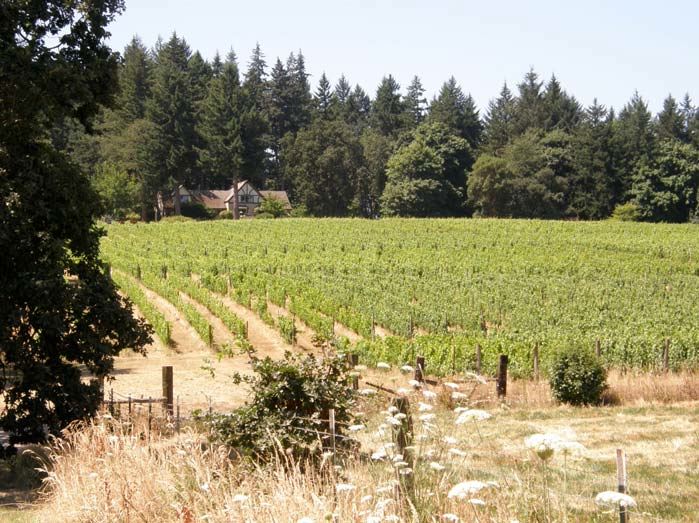 Erin (left in photo below) joined Raney as assistant winemaker in 2007 and took over complete charge of the winery beginning with the 2010 vintage after the sale of the winery. Raney continues to consult and Erin says, “Nothing will change since our winemaking and vineyard management philosophies are virtually identical.”
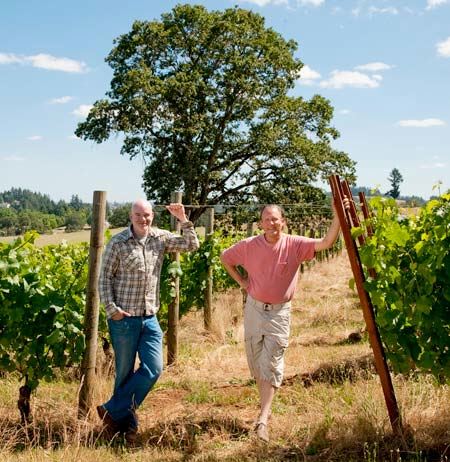
Erin and and Jordan launched their own label, Haden Fig, with the 2007 vintage. Their hip label features a
painting of a Northern Saw-whet Owl, a bird Jordan became enamored with while working at the Portland
Audobon Society as a volunteer veterinarian. The name, “Haden Fig,” requires some explanation and I refer
you to the PinotFile Winery Directory for that information. The Haden Fig wines are from purchased fruit, are
very user-friendly, and sensibly priced. Haden Fig wines are sold on the website (www.hadenfig.com) and
through a mailing list.
I tasted briefly several Haden Fig and Evesham Wood wines at the winery with Erin.
2010 Haden Fig Willamette Valley Pinot Noir
13.0% alc., 800 cases, $24. Aged in 10% new French oak.
·
Moderately rich mix of dark stone and berry fruit aromas and flavors. A user-friendly, fruity wine. Decent.
2010 Haden Fig Cancilla Vineyard Eola-Amity Hills Barrel Select Pinot Noir
13.25% alc., $30.
Aged in 25% new French oak. 50% each Pommard and Dijon clones.
·
Moderately dark reddish-purple
color in the glass. Middleweight flavors of dark red and purple fruit framed by good acidity and
backed by firm, ripe tannins. Very good.
2010 Haden Fig Bjornson Vineyard Eola-Amity Hills Pinot Noir
13.5% alc., 75 cases, $30, sold
out.
·
A very impressive wine offering vibrant pie-filling flavors with a pleasant accent of baking spice.
Nicely composed and thoroughly enjoyable with a memorable finish. Very good.
2010 Evesham Wood Temperance Hill Vineyard Eola-Amity Hills Pinot Noir
13.0% alc., 100
cases, $30. Release November 2012. Retro label. From a block planted in 1982. Aged in neutral
barrels.
·
Medium reddish-purple color in the glass. Lovely nose, smelling of a field replete with spring
flowers, and a medley of well-spiced stone fruits. Luscious core of dark red cherries with subtle
cedary oak flavors folded in nicely. A special wine that is quite approachable now. Very good (+).
2010 Evesham Wood Mahonia Vineyard Willamette Valley Pinot Noir
13.2% alc., 100 cases, $30. Retro
Evesham Wood label. Old vines planted on volcanic soil. Aged in 20% new French oak.
·
Moderately deep
reddish-purple color in the glass. Very unique nose offering aromas of black stone fruits, spice and violets.
Slightly muscular, with forceful tannins still dominating the fruit. Needs several years in the cellar. Good.
2010 Evesham Wood Ilahe Vineyard Willamette Valley Pinot Noir
13.5% alc., 150 cases, $30. Release
November 2012. A single vineyard barrel selection produced since 2007. Primarily Pommard clone.
·
Moderately rich array of darker berry fruit with an earthy undertone. Chewy, with firm tannins, and quite
restrained at this stage. Good.
2009 Evesham Wood Cuvée “J” Eola-Amity Hills Pinot Noir
$44. Release November 2012. A reserve
barrel selection from Le Puits Sec Vineyard. Primarily estate fruit. Aged in 40% new French oak.
·
The
additional oak adds more structure to this wine which is nicely fruited with exotic spice accents. Smooth on the
palate with an extraordinarily long finish. This beauty will be the showpiece of a special dinner after a few
years in the cellar. Very good.
2010 Evesham Wood Le Puits Sec Eola-Amity Hills Pinot Noir
13.5% alc., 500 cases, $36.
Release September 2012.
·
One of the truly great Pinot Noirs of Oregon and a ridiculous value. At
this year’s IPNC, I was tasting this wine alongside wine critic Josh Raynolds, and as we sampled the
wine, we just looked at each other and shook our head. The epitome of Pinot Noir, with all the
elegance and class that you want from this grape, packing plenty of depth of flavor that only old vines
can give, and ending with a magnificent finish. Very good (+). If you buy only one Pinot Noir from
Oregon’s 2010 vintage, this would be a good choice.
Additional wines: 2010 Eola-Amity Hills Pinot Noir (8 barrels from Erin’s Hidden Rock Vineyard and 8 barrels
from Eola Springs Vineyard which is adjacent Le Puits Sec, $26), 2010 La Grive Bleue Pinot Noir (younger
vines in Le Puits Sec Vineyard, $28), 2011 Willamette Valley (September release, $18), Le Puts Sec
(September release, $36), and 2008 Cuvée Bélier Pinot Noir (one barrel of Le Puits Sec bottled separately,
24-year-old vines, 24 cases, $60). Bruno Willamette Valley Pinot Noir is an inexpensive bottling made by
Evesham Wood and is only available in Oregon.
Et Fille: In The Pink
Howard Mozeico and his daughter, Jessica. (Et Fille translates to “And Daughter” in French) craft small lots of
distinctive Willamette Valley Pinot Noirs from several prime vineyards including the well-known Maresh
Vineyard. The 1,500 case annual production is vinified at August Cellars, a modern gravity flow winery that
houses eight separately bonded wineries that share space and equipment.
I have followed the young winery since the 2005 vintage and have been consistently pleased with the wines. I
visited Jessica at August Cellars and tasted some interesting wines with her from the 2010 vintage.
2010 Et Fille Deux Vert Vineyard Yamhill-Carlton District Viognier
200 cases, $24. This vineyard is
located at a warmer site near Lenné Estate and has been a vineyard-designate for Et Fille since 2005.
·
Typical
varietal aromas of tropical fruits including ripe pineapple with a nutty, almond note. Satiny on the palate with
flavors of tropical citrus and honey, backed by a good cut of acidity. Good.
2010 Et Fille Heredity Willamette Valley Pinot Noir
13.1% alc., 176 cases, $34. A reserve blend
from four Willamette Valley vineyards. Aged 10 months in 25% new French oak.
·
Moderate reddishpurple
color in the glass. Aromas of black raspberries, black cherries, strawberries and oak. Soft
and smooth and moderately rich, with shy fruit expression, offering a citrus-peel and oak imbued
finish. Tasted 30 minutes later, the oak had become more integrated and the fruit had moved more to
the forefront. Needs decanting or time. Good (+).
2010 Et Fille Palmer Creek Vineyard Eola-Amity Hills Pinot Noir
13.3% alc., 175 cases, $42. The owners
live on the site and meticulously farm this vineyard.
·
Moderately deep reddish-purple color in the glass. Bright
and persistent aromas of fresh black raspberries, cherries, spice and vanilla cream. Wow! Juicy and crisp with
flavors echoing the nose. Appealing roundness with supple tannins, bright acidity, and a fruit-driven finish that
is soft and long. Impressive balance. Best wine ever from this vineyard for Et Fille. Very good (+).
2007 Et Fille Maresh Vineyard Jim’s Block Dundee Hills Pinot Noir
12.7% alc., 101 cases +, $48. There is
a great story behind this wine that you should read (www.etfille.com/wines/07jims.html). A one-time tribute to
Maresh Vineyard. Sourced from a 1971 planting by Jim Maresh (Block 1) of Wädenswil. Aged 9 months in
50% new French oak.
·
Moderately light reddish-purple color in the glass. Delicate, but pleasing aromas of red
cherries and berries, dried rose petals and sandalwood. Light and graceful on the palate, with savory red fruit
flavors and a hint of complimentary oak. A relatively austere wine styled in the Burgundian tradition.
Very good.
J.Christopher Wines: Pinot in Rhythm
Jay Somers began as a master brewer at McMenamins pub in Portland, apprenticed as a winemaker with John
Paul at Cameron Winery, and then launched his own label in 1996, J. Christopher Wines, specializing in Pinot
Noir, Chardonnay and Sauvignon Blanc. He later formed a partnership with Dr. Ernst Loosen of Dr. Loosen
and J.L. Wolf in Germany called Appassionata (the name of a limited production Pinot Noir that eventually will
be sourced primarily or exclusively from estate fruit). A modern winery was built on Chehalem Mountain at the
same time as the first blocks of Appassionata Vineyard were planted on the estate. A total of 23 acres of Pinot
Noir and Sauvignon Blanc are being established in stages. The vines will be dry farmed after they are
established, and all viticulture is biodynamic. The first estate wines will be released with the 2012 vintage.
I visited the winery on a day that Jay was unavailable. The facility is quite impressive but the tasting
experience was not flattering. A few bottles were set up on a barrel in one of the barrel aging rooms with a
spittoon nearby, but no place to sit or write. I did the best I could. I can tell you that I have enjoyed the few J.
Christopher Pinot Noirs I have tasted in the past, prompting my desire to visit. The style is appealingly
restrained and very food-friendly. The three Terroir Series wines offer a chance to compare AVA terroir and are
very good wines for the price. I did not get to taste the current release of Appassionata Pinot Noir sourced
from Bella Vida and Abbey Ridge vineyards ($75).
All the Pinot Noirs from the 2010 vintage are about 13% alcohol. Approximately 8,000 cases were produced in
this vintage, below the usual production of 11,000 cases annually. Tasting is by appointment (503-554-9572).
Visit the website at www.jchristopherwines.com.
2010 J. Christopher Willamette Valley Pinot Noir
2,100 cases, $26. Sourced from four Willamette Valley
AVAs. Native yeast fermentations and up to 18 months in barrel.
·
Fresh, light, and easy to drink, featuring red
fruits with an herbal undertone. Supple tannins and lively acidity. Decent.
2010 J. Christopher Dundee Hills Cuvée Terroir Series Pinot Noir
275 cases, $35. A blend of
selected barrels from several vineyards (Bella Vida, Baptista Maresh, Charlie’s, Abbey Ridge and Le
Pavillon).
·
Moderately rich dark red cherry and plum aromas and flavors, framed by juicy acidity and
supple tannins. Good (+).
2010 J. Christopher “Nuages” Chehalem Mountains Terroir Series Pinot Noir
335 cases, $35.
A tribute to Django Rheinhart’s “Nuages,” one of Jay’s favorite gypsy jazz tunes. Sourced from
Adams, Lia’s and Olenik vineyards located nearby in the Chehalem Mountains.
·
Light reddish-purple
color in the glass. Impressive thrust of mountain raspberry flavor caressed by mild, grippy tannins.
A delicious wine with vibrant fruitiness that finishes on a refreshing, acid-driven note. Very good.
2010 J. Christopher “Lumiere” Eola-Amity Hills Terroir Series Pinot Noir
170 cases, $35. Sourced from
two small vineyards, Dubay and Three Angels.
·
Moderately light reddish-purple color in the glass. Black
raspberries and blackberries are featured clothed in firm, muscular tannins. Good.
2011 J. Christopher Croft Vineyard Willamette Valley Sauvignon Blanc
13.0% alc., 100 cases, $25. Coolfermented
in stainless steel, no MLF.
·
Aromas of citrus, grass and resin. A bit steely on the palate with citrus
and passion fruit flavors, finishing with a lemony flourish. Decent.
2011 J. Christopher Croft Vineyard Uber Sauvignon Willamette Valley Sauvignon Blanc
13.0%
alc., $35. Aged in Acacia wood for 8 months.
·
An interesting offering that is less grassy than the
regular Croft Vineyard bottling, offering a pleasing fullness and interesting tannin interplay, finishing
with a bracing cut of lemon-driven acidity. I thoroughly enjoyed this wine and bought a bottle to play
with at home. Very good.
Anam Cara Cellars: Where’s Mark?
The words, “Anam Cara” are Celtic for “friend of my soul,” and speaks to the lasting friendships that develop
over time. Once you visit and meet Sheila and Nick Nicholas, you will develop a deep friendship, for these
winegrowers are very sociable, genuine people. Their 34-acre vineyard, which was originally an overgrown nut
and plum orchard, has soils that are primarily wind-blown ice age sediments over a bedrock of volcanic Jory.
Boulders and rocks scattered across the vineyard were deposited by the Missoula floods, many now covered
with Laurelwood and Yamhill soils of varying depths. The original 28 acres were planted in 2001, with five
blocks of Pinot Noir including Pommard and Dijon clones 114, 115, 667 and 777. An acre each of Riesling and
Gewürztraminer were added, and in 2008, an additional 6 acres were planted to equal blocks of Riesling,
Chardonnay and Wädenswil clone Pinot Noir.
All wines produced are Oregon Certified Sustainable and 100% estate fruit. The new winemaker is Michael
Collier, who finished the 2009 vintage wines and vinified the 2010 vintage wines. Collier was an assistant
winemaker to the former Anam Cara winemaker, Aron Hess, at 12th and Maple Wine Company.
I tasted the 2010 vintage Pinot Noirs, all of which are impressive wines that offer depth and high-voltage
concentration of flavors at lower alcohol levels. Only the 2010 Vineyard Selection Pinot Noir has been
released; the remainder of the wines are scheduled for a fall 2012 release, except the Mark V which will be
released in mid 2013.
The limited production 2010 Estate Chardonnay was released on August 25, 2012. I have never been
particularly enamored with most Oregon Chardonnays even though the potential for this grape in Oregon would
seem boundless. This offering is easily one of the best I have ever had from Oregon.
Visit the website at www.anamcaracellars to join the mailing list and be notified when these wines are released.
Tasting is by appointment or visit the tasting room in downtown Newberg.
2010 Anam Cara Vineyard Selection Chehalem Mountains Pinot Noir
13.0% alc., 450 cases, $24, screw
cap. Primarily a restaurant by-the-glass program wine. Aged in once-filled and neutral oak. Predominantly
Dijon 114.
·
Light reddish color in the glass. Pleasant perfume of red berries, wild strawberries and spice. Soft,
smooth and elegant, with a lighter-weighted core of red fruits accented with notes of herbs and tar. Decent.
2010 Anam Cara Nicholas Estate Chehalem Mountains Pinot Noir
13.2% alc., 1,200 cases, $32. The
flagship wine, reflecting all five blocks of the vineyard Pinot Noir. Aged in 23% new French oak. A mix of Dijon
and Pommard clones.
·
Light red color in the glass. Very fragrant, plush with bright aromas of fresh berries and
red plums. A pretty wine that exudes finesse, offering tasty raspberry and marionberry flavors, framed by
gossamer tannins, finishing with a tasty raspberry display. Very good.
2010 Anam Cara Reserve Chehalem Mountains Pinot Noir
13.4% alc., 195 cases, $45. 10 rows in each
block are set aside as Reserve potential and maintain a yield of not more than 1.5 tons per acre. The final
blend is chosen by barrel selection. Dijon clones 777, 115, 114 and Pommard. Aged in 37% new French oak.
·
Light reddish-purple color in the glass. Deeply perfumed with dark red pie cherries, fraise du bois and stem.
Middleweight flavors of dark red berries fan out nicely on the palate, with notes of earth, tar and oak adding
interest. A second pass at the wine was made after pouring through a Venturi. The wine became much more
expressive aromatically with aromas and flavors of fresh-picked berries and savory herbs. Elegant and soft in
the mouth with a plush finish. Not fully forthcoming, but well balanced, and should be terrific after a few years
in the cellar. A commendable expression of the vintage. Very good.
2010 Anam Cara Heather’s Vineyard Chehalem Mountains Pinot Noir
13.4% alc., 50 cases, $65. The
most elegant expression of the vineyard, using the lightest oak treatment (no new oak, 100% once-filled
barrels). 50% Dijon 114, 36% Dijon 777 and 14% Pommard. Usually the wine is from ten rows of Dijon clone
114 in a late ripening block cropped to 1.5 tons per acre. The 2010 bird invasion wiped out these rows which
abutted the tree line. The blending process then opened to include other clones. The wine is named for the
Nicholas’ daughter.
·
Light reddish-purple color in the glass. Very fragrant, like a well-perfumed woman with a
dab of crushed cherries and sandalwood behind her ear. See-through elegance, featuring ripe dark candied
griottes cherries, sweet and seductive in the middle and languorous and slinky at the end. Will pick up intensity
with more time in the bottle. Very good (+).
2010 Anam Cara Mark V Chehalem Mountains Pinot Noir
13.4% alc., 50 cases, $65. Largest percentage
of new oak (50%). 77% 777, 13% Pommard and 10% 667. Crafted to be big and rich choosing the boldest
clones and blend from the Reserve rows and barrels. Named for the Nicholas’ son, the Roman numerals
denote the wine’s place in the series.
·
Deepest reddish-purple color in the lineup. Intensely perfumed with
perfectly ripe dark red berries with a complimentary scent of oak and dark rose petals. The most intense wine
in this vintage and the wine with the most length. It hits the mid palate with a vengeance, expands in the
mouth, and ends with a voluptuous charge of fruit that satiates the senses for a minute. A very young, but
remarkable wine that is the best ever Mark release from Anam Cara. Grab a few bottles for your cellar; you will
thank me down the line. Very good (+).
Anne Amie Vineyards: Red and White Pinot Noir
Winemaker Thomas Houseman is a former modern dancer who learned his fermentation making beer in his
New York apartment, went on to learn winemaking at University of California at Fresno, and paid his dues at
wineries in Anderson Valley, New Zealand and the Willamette Valley before becoming the Director of
Winemaking at Anne Amie. Anne Amie had struggled since its founding in 1999, but it was clear that the
owner, Robert Pamplin, Jr., had the resources to succeed. The hiring of Thomas quickly transformed Anne
Amie and positioned the winery in the upper echelon of Oregon wine producers. Thomas can be loose, a bit
crazy, and more enthusiastic than anyone deserves to be, but he knows how to make great wine (with a grin).
Anne Amie Vineyards provides Thomas with a widely varied estate vineyard palate to work with and gives him
a long reign to succeed. Anne Amie also has access to grapes from several prominent vineyards in the
Willamette Valley, adding to the possibilities.
Anne Amie Vineyards is located at 6580 NE Mineral Springs Road in Carlton. The tasting room has a pleasant
outdoor patio with view of the estate and surrounding vineyards in the Yamhill-Carlton AVA. The winery
specializes in Pinot Noir, but offers a number of other white varietals. Prismé, the winery’s Pinot Noir Blanc, is
one of the best examples produced in Oregon (see article on Pinot Noir Blanc in this issue).
I had a seated tasting with Thomas at Annie Amie and amongst the ribald talk and laughing, I tasted some
wine. (Thomas is pictured above to my right at this year’s World of Pinot Noir).
Thomas says the 2010 vintage wines “are my favorite wines I have ever made. He has committed to screw
cap closure in nearly all the Annie Amie wines beginning with the 2010 vintage which will be released over the
latter months of 2012 and early 2013. Visit the website at www.anneamie.com for availability of the wines.
2010 Annie Amie Willamette Valley Pinot Noir
12.9% alc., pH 3.57, TA 0.62, 1,971 cases, $35. Release February 2013. Anne Amie Estate, Twelve Oaks Estate, Rainbow Ridge and Alloro vineyards. 7-20 day cold soak, extended maceration, on skins 28-49 days. Aged on lees in 15% new, 34% 1-year, and 51% neutral French oak barrels for 16 months. Aged in bottle for 12 months before release.
·
Raspberry color in the glass. Nicely scented
with aromas of fresh raspberry coulis and spice. Moderately rich with flavors of sweet red plums and dark
raspberries, with the fruit pulled into line with good acidity and fine tannins. A very impressive Willamette Valley
bottling that can perform beautifully as a daily drinker. I recommend it for case buys. Very good.
2010 Anne Amie Twelve Oaks Estate Chehalem Mountains Pinot Noir
13.3% alc., pH 3.57, TA 0.63, 124 cases, $50. 100% Twelve Oaks Estate Vineyard in the Chehalem Mountains. 5-day cold soak, 10-day fermentation. Aged 16 months in 40% new, 20% 1-year and 40% neutral French oak barrels. Bottled unfined and unfiltered and bottle aged for 12 months before release.
·
Moderately light
reddish-purple color in the glass. The aromas leap out of the glass with effusive notes of fresh berries, roses
and spice. Deep, dark red berry, strawberry nectar reduction, and brown spice flavors with well proportioned
acidity and tannins, finishing with a sappy cherry highlight. Very good (+).
2010 Anne Amie Estate Vineyard Yamhill-Carlton Pinot Noir
13.4% alc., pH 3.58, TA 0.59, 124 cases, $50. Release May 2013. 100% estate vineyard grapes. Pommard and Dijon 115 clones
grown on Willakenzie soils. Aged 16 months in 60% new, 20% 1-year and 20% neutral French oak barrels. Bottled unfined and unfiltered and bottle aged for 12 months before release.
·
Medium reddish-purple color in the glass. Vibrant aromas of fresh dark cherries
and berries complimented with exotic spices. A serious wine with structural power, featuring sappy dark plum
and blackberry flavors, backed by frisky acidity and fine-grain tannins, finishing with poise and richness. Still a
Lolita. Very good (+).
2009 Anne Amie L’Iris Willamette Valley Pinot Noir
14.1% alc., 260 cases, pH 3.63, TA 0.56, $75. Release
May 2013. A barrel selection sourced from several vineyards including Anne Amie Estate and Twelve Oaks
Estate. Pommard, 777, 115 and 828 clones. 100% de-stemmed. Aged 18 months in 20% new, 40% 1-year,
and 40% neutral French oak. Unfined and unfiltered.
·
Moderately deep reddish-purple color in the glass. A
wine with serious intentions and longevity. Bright aromas of berry mash with baking spices and clove.
Moderately rich core of black cherry, berry and plum fruit flavors with an earthy, tea accent. Powerfully
structured so will need time for the tannins to soften. Impressive. Very good.
2009 Anne Amie Prismé Yamhill-Carlton Pinot Noir Blanc
14.1% alc., 404 cases, $45, screw cap. Sourced
from Anne Amie Estate and Rainbow Ridge vineyards. Barrel fermented, full MOF, and aged on lees for 18
months. Previously reviewed May 11, 2012.
·
Aromas of white stone fruits, biscuit, crème brulée, and roasted
nuts. Delicious and full on the palate with slight viscosity, offering flavors of baked pears, white peaches, and
brown butter. A highly enjoyable, unique wine that challenges the preconceived sense of Pinot Noir. Oregon’s
finest Pinot Noir blanc. Very good (+).
2011 Anne Amie Cuvée A Pinot Noir barrel sample 12.9% alc.. Multiple vineyards, soils and clones. 10-15%
whole cluster. Aged 10 months in 20.3% new French oak barrels. The winery’s entry level Pinot Noir. More
structured than the 2010 offering with the same weight of sweet, red and blue fruits. Always a reliable wine.
Decent.
2011 Anne Amie Willamette Valley Pinot Noir barrel sample More power than the 2010 version, but
otherwise very similar, with good depth at low alcohol. Solid.
2011 Anne Amie L’Iris Willamette Valley Pinot Noir barrel sample Deep color with striking fruit
concentration and density backed by great acidity. Will spend another year in bottle. Terrific.
2011 Anne Amie Twelve Oaks Vineyard Chehalem Mountains Pinot Noir barrel sample Very promising
with great fruit purity and very refined tannins. Solid.
2011 Anne Amie Estate Vineyard Yamhill-Carlton Pinot Noir barrel sample Impressive fruit density and hitone
aromatics backed by very fine-grain tannins. Outstanding.
2010 Technique vs Terroir: The Cube Experiment Three wines crafted by Thomas Houseman at Anne
Amie. See seminar at this year’s World of Pinot Noir (www.princeofpinot.com/article/1195/). A presentation of
The Cube Experiment was also offered at this year’s International Pinot Noir Celebration. Three wines from
Pommard clone, one from Annie Amie estate Willamette Valley vineyard, one from Bouchaine estate Carneros
vineyard and one from Lincourt Sta. Rita Hills estate vineyard, all vinified identically by Thomas. When the
wines are tasted from the same vineyard made by three different winemakers, the winemakers hand stands
out, but if one tastes the three different regional wines made by the same winemaker, the regions stand out (I
was able to guess blind one of the regions but was unsure about the other two, mistakenly switching them, but
after I was told the correct regions, I could concur). These wines will be available for purchase so one can
taste the wines in a similar blind fashion, looking for winemaker style and/or regional (terroir) character (inquire
at the winery).
White Rose Estate Winery & Vineyard: Got Whole Cluster?
In 2000, successful businessperson Greg Sanders bought the storied 10-acre White Rose Vineyard located in
a prime southeast-facing slope in the Dundee Hills AVA of Yamhill County. The vineyard was planted in 1980 to
own-rooted Pommard clone at an elevation of 870 feet on deep Jory soil. Situated just west of Domaine
Drouhin Oregon and east of Domaine Serene, this vineyard commands a striking view of the Willamette Valley
and the hilltop location contributes to a long hang time.
Greg had his ups and downs early on, but he has persevered, and his wines are now among the most
distinctive in the Willamette Valley. Greg began producing Pinot Noir in 2001 and after seven vintages as
winemaker, he settled into a consulting role and appointed Jesus Guillen the winemaker in 2008. Jesus has
managed the day-to-day winemaking procedures since 2002 (Greg lives in Southern California where his
manufacturing business is located). A giant leap in quality arrived with the 2008 vintage, when the Wine
Advocate gave the wines very high scores and two of the White Rose wines were PinotFile All-Americans. As I
noted, “Sander’s dreams of Grand Cru quality wines from Oregon have been realized.”
In 2009, Greg acquired an additional 4 acres of vineyard immediately north of the original site (Guillen
Vineyard). Planted in 2001 to Dijon clone 115 grafted onto American rootstock, this site is showing
considerable potential. Fruit is also purchased from a number of growers in the Yamhill-Carlton District AVA,
Dundee Hills AVA, and Chehalem Mountains AVA. Greg visits the vineyards personally, selecting the best rows
for his appellation cuvées.
Greg believes in grooming his vines with a higher canopy, believing this leads to slower maturation and longer
hang time. Most wineries hedge their vines at about a 5 to 6 foot level. The photo below shows not only the
high canopy, but the deep reddish-brown soil typical of the Dundee Hills.
I spent some time with Greg on my visit in July, and I came away impressed by his winemaking operation, his
intuitiveness, and his meticulous approach. He uses a very high percentage of whole cluster fermentation
(40%-100%). His reasoning is that this approach allows the wines to be drinkable early on, but holds back the
fruit to fully emerge and improve later as the wine ages. It is a style that offers the best of New World (early
drink ability) and Old World (age ability) Pinot Noir.
Greg’s team hand carries buckets of just-picked grapes at harvest directly to the fermentation vats located in
the winery on the property. Every step thereafter is intended to avoid seed tannins which can be harsh and
take years to resolve. He uses an old-fashioned hand crank basket press so he can carefully control pressure,
preserving some liquid around the seeds without crushing them before they are discarded. Pump overs are
used to disseminate the cap, and the wines are barrel fermented and aged in a low percentage of new oak
(10%).
The 2010 White Rose wines have not been released and I will review them later this year. I did taste two 2009
Pinot Noirs at the tasting bar. To guarantee an allocation of the coveted 2010 wines, join the Explorer’s or
Collector’s Wine Club (www.whiterosewines.com). The wines are not inexpensive, but then Pinot Noir at its
epitome never is. The tasting room is open daily from 11:00 to 5:00. Tours by appointment (503-864-2328).
Greg treated me to a taste of 2011 Pinot Noirs from White Rose Vineyard and Luciole Vineyard; the White
Rose Estate Pinot Noir was stunning and I could still taste it the next day.
2009 White Rose Estate White Rose Vineyard Dundee Hills Pinot Noir
13.8% alc., $70. Select barrels of
the four oldest blocks in the estate vineyard. 60% whole cluster.
·
Moderately light reddish-purple color in the
glass. Shy, but pleasing aromas of dark raspberries, spice and clove. Middle weight flavors of juicy
raspberries and cherries with a note of seasoned oak, spice and a hint of good stem. Supportive, ripe tannins
and impressive persistence and intensity on the generous finish. A delicious wine that is very outgoing now,
but will stay the course for many years. Very good (+).
2009 White Rose Estate White Rose Vineyard “Guillen” Dundee Hills Pinot Noir
13.9% alc., $60.
Produced from Block 5 of White Rose Vineyard, Dijon 115 clone planted in 2001.
·
Light reddish-purple color in
the glass. Shy aromatics with delicate aromas of black and blue berries, spice and briar. Mid weight flavors of
red and black raspberries with an earthy undertone and a finishing kick of spice and toasty oak. Well-mannered
with fine tannins and juicy acidity. Good.
Added Ramblings on the Willamette Pinot Trail
I visited Maggie at her warehouse winery in Dundee to taste the 2011 vintage out of barrel and hear about future plans. There were a number of vineyards represented including Hyland, Nysa, Old School, Cherry Grove, Shea (Pommard and Wädenswil clones), Antica Terra old vine (Wädenswil) and new vine (Coury clone). She has quite a palette of grapes to work with. All the barrels are tasted blind before arriving at the blend for her wines. There are no predetermined combination, although the Botanica bottling has usually been primarily from Shea Vineyard. The 2011 wines, like the 2010 brethren, show excellent depth and concentration, low alcohols, but more structure and tannin presumably from the heat spikes in September of 2011 that led to quick ripening and skin tannin changes. The Antica Terra Erratica Rosé ($50) is quite unique among Oregon examples. It is taken very seriously by Maggie who plans to produce 450 cases in 2011. She describes her technique: “When certain fermentation bins have special aromatic intensity, often after 6 to 8 days on the skins, just before the juice becomes red wine, I drain off the juice to barrel, and age it on the lees for a year before bottling. This is not how rosé is produced in a conventional sense.”
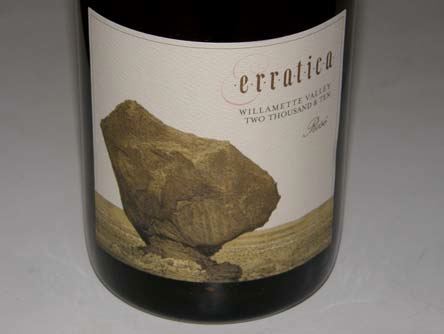 A sparkling wine is being produced and Maggie has a number of other surprises in store which she declined to elucidate. She was eager to talk about the onsite tasting experience that is being planned. Curated by Antica Terra Director and Master Sommelier Nate Ready, visitors will not only be able to taste Antica Terra’s current releases, but also a rotating selection of wines from around the world that have inspired and sustained the Antica Terra creative process, ranging from grower Champagnes and Grand Cru Burgundies, to esoteric bottlings from rare, indigenous grapes that feature innovative winemaking techniques. As of late July, the program had not been launched but stay tuned. Antica Terra wines are sold primarily through a mailing list at www.anticaterra.com.
Big Table Farm I had met Clare Carver and Brian Marcy and reviewed a number of their excellent wines, but had never visited the Big Table Farm until July. After traversing several miles of unpaved, gravel roads, I came upon an over-100-year-old farmhouse and an active 70-acre working farm alive with chickens, pigs, horses, cattle, and beehives. Clare manages the farm and animals, and does the marketing for the Big Table Farm wines. She is a talented artist, and has designed wine labels for over 100 wineries including Beaux Frères, Phelps Creek and Miner Family Vineyards. Big Table Farm wine labels are adorned with endearing drawings of the farm’s animals. Brian is a talented winemaker who has worked at Turley Wine Cellars, Neyers Vineyards, Blankiet Estate and Marcassin and crafts superb single-vineyard Pinot Noirs from Pelos Sandberg Vineyard and Resonance Vineyard. He is also quite a chef, and cooked dinner for my wife, Patti, and myself. The couple entertain quite frequently, providing a unique winery experience. A small tasting bar is set up in their home, and Clare’s art, which is for sale, adorns the rooms. A visit is highly recommended! Consult the excellent website at www.bigtablefarm.com. Tasting and tours are by appointment.
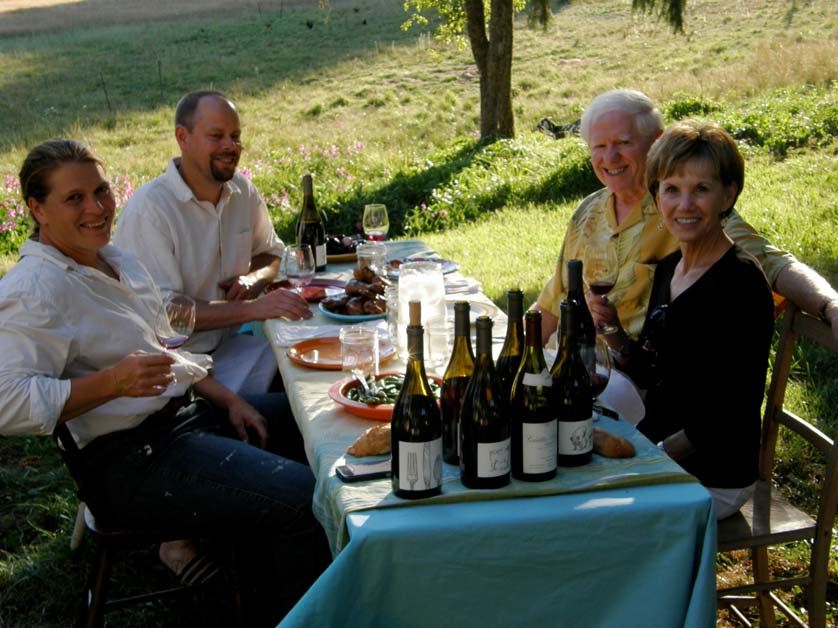 Le Puy: The Place to Stay in the Willamette Valley There are a number of excellent options for wine tourism lodging in the Willamette Valley (see my Pinot Trail Travel Directory), but my top choice would be Le Puy: A Wine Valley Inn in Newberg. This modern 8-room bed and breakfast inn is operated by very congenial hosts, Andy Kosusko and Lea Duffy, both former architects from the Seattle area. The inn sits on ten acres of a tranquil hillside with expansive views of the Chehalem Mountains. Everything you need is at hand and the gourmet breakfasts will fuel you for an entire day of wine tasting. The location is ideal, situated on Highway 240, with all the wineries in the Yamhill-Carlton District, Dundee Hills and Chehalem Mountains within a short bike or car ride. In addition, it is only a 10 minute drive to some of the best dining in the Valley including Jory at The Allison and Recipe in Newberg (see below), and Tina’s and Paulee in Dundee. I stayed here as my base of operations the week after IPNC, and I am eager to return. Visit the website at www.lepuy-inn.com.
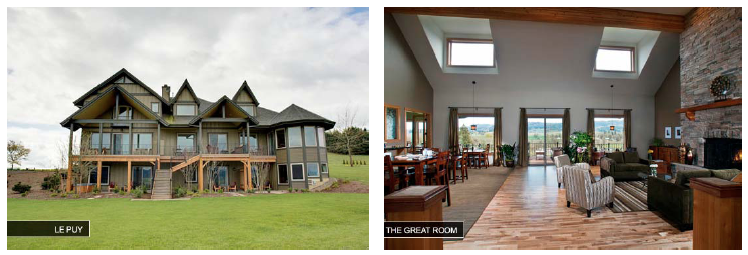 Recipe: The Place to Eat in the Willamette Valley Dustin Wyant and long time local chef Paul Bachand, who partnered a few years back in launching the Farm to Fork restaurant in the Inn at Red Hills, have reunited at Recipe. They renovated an old Victorian home in downtown Newberg, and offer lunch and dinner both indoors and outdoors on a patio. A community table provides a setting to enjoy dining with local visitors, winemakers and townsfolk. The emphasis is on fresh seasonal ingredients from local farmers and growers. Meats are cured and smoked in house, buratta cheese is hand formed each morning, and pasta is made fresh daily using locally milled flour and farm eggs. The wine list includes hard to find releases from small Oregon producers and wine service is exceptional. The restaurant received a 2013 Superior Cellar Award from Oregon Wine Press. If you go, don’t miss the house-made buratta with toy box tomatoes, basil-walnut pesto and ficelle toast or the escargot served in profiteroles with garlic cream and parsley butter. The restaurant is open every day except Monday and reservations are advised but not required. Visit www.recipenewbergor.com. McMinnville: Where the Action Is Downtown McMinnville has several wine tasting rooms in a roughly 6 block radius including Willamette Valley Vineyards Wine Center, Twelve, Anthony Dell, R. Stuart & Co, Wine Bar, Panther Creek Cellars, Dominio IV, The Eyrie Vineyards, Remy Wines, Westrey Wine Company, and Walnut City Wineworks. Visit www.mcminnvilledowntownwines.org. The McMinnville Public Market is a Saturday gathering of artists, bakers, farmers, winemakers, musicians, chefs, and purveyors, year round at 845 NE 5th or on the corner of 8th & Alpine, just a short walk from downtown McMinnville. Visit www.mcminnvillepublicmarket.com. Finally, McMinnville’s Art & Wine Walk is held the third Saturday of every month from 4:00 to 8:00 p.m.. 20 shops and galleries open late and dozens of wineries pouring. Concentration of Tasting Rooms in Downtown Newberg Eight tasting rooms within walking distance including Anam Cara Cellars, Artisanal Wine Cellars, Chehalem, Dark Horse Tasting Room (Medici, Sineann, Ferraro Cellar), Fox Farm Vineyards & Wine Bar, Hip Chicks Do Wine, Longplay Wine and Spangler Vineyards (Umpqua Valley). Visit www.newbergdowntown.org. Voodoo Martini & Wine Bar is owned by Cal Erath, Dick Erath’s son, so not surprisingly one can find many Pinot Noirs from very small producers. I stopped in to try Cal’s Pinot Noir from Dick’s vineyard in Arizona, but it quickly sold out. Carlton has Many Appealing Tasting Rooms Also There has been as many as twenty, but some come and go. Most are open on weekends, a few daily. Carlton is seven miles north of McMinnville. Look for Tyrus Evan in the Depot, Carlton Winemaker’s Studio (8 wineries including Andrew Rich and Hamacher), Cliff Creek Cellars (southern Oregon), the Tasting Room (several select Oregon producers including Arterberry Maresh, Ayres, Beaux Frères, Big Table Farm, Cameron, De Lancellotii, Domaine Drouhin, EIEIO, Libra, and Soter), Scott Paul Wines (Oregon Pinot Noir and Burgundy), Carlton Cellars, Cana’s Feast Winery, Domaine Coteau, Carlo & Julian Winery, Solena Cellars, Utopia Vineyard, and Seven of Hearts/ Luminous Hills.

More 2010 Oregon Pinot Noirs
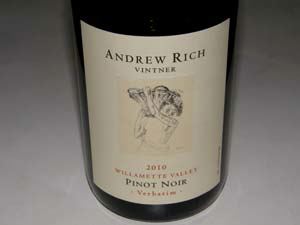 2010 Andrew Rich Verbatim Willamette Valley Pinot Noir 13.5% alc., 833 , $30. Rich’s blend that best captures the vintage and the expression of Willamette Valley Pinot Noir. Sourced from Ribbon Ridge, La Colina, and Momtazi Family vineyards. Aged 15 months in French oak barrels. · Moderately light reddish-purple color in the glass. Immediately appealing upon opening the bottle with fresh red cherry and berry aromas accented with notes of spice and sandalwood. Dances lightly on the palate, and delivers plenty of Pinot flavor. Impeccably balanced with supple tannins, finishing with a cherry focus that lingers. Captures the 2010 Willamette Valley vintage perfectly.
2010 Archery Summit Premier Cuvée Willamette Valley Pinot Noir 13.5% alc., $35.99. 100% estate grown and estate bottled. Sourced from five vineyards. · Moderately dark reddish-purple color in the bottle. At this early stage this wine is dominated by oak and tannin. Aromas of black cherries and coffee-scented oak. Soft in the mouth with a gentle cherry flavor, largely buried in oak and tannin. Tasted the next day from a previously opened and re-corked bottle, the lovely fruit core had begun to emerge and the oak was better integrated. Give this wine a few years in the cellar. Good.
2010 Argyle Willamette Valley Pinot Noir 13.0% alc., $17.50, screw cap. “Double macerated” - once before fermentation and again after fermentation. · Light garnet color in the glass. Aromas of strawberries, cherries and herbal oak. Soft in the mouth with lighter weight flavors of red cherries and berries and a dusting of oak. An easy drinker with no special message. Decent.
2010 Cardwell Hill Cellars Estate Bottled Willamette Valley Pinot Noir 13.2% alc., $24. Wädenswil (1985), Pommard, and Dijon 115, 777. Aged 10 months in French oak. · Light reddishpurple color in the glass. Very shy aromas of redder fruits and underbrush. Tasty red cherry and strawberry fruits, lifted by good acidity and framed by supple tannins. Very flavorful, with the aromatics lagging behind at this early stage. Good.
2010 Domaine Drouhin Oregon Willamette Valley Pinot Noir 13.9% alc., $40. · Moderately light reddish-purple color in the glass. Typical Dundee Hills aromas and flavors of red cherries and wild strawberries. Very light, even thin, with a lacy delicacy, offering polished tannins and a bright, cherry-driven finish. Not particularly expressive at this stage, lacking interest and impact, but based on the history of this wine picking up interest over time and having excellent age ability, I would give it a chance. Decent.
2010 Evening Land Red Queen Seven Springs Vineyard Eola-Amity Hills Pinot Noir 13.0% alc., 311 cases, $75. From a specific vineyard block that sits at the highest point of the hill, where the volcanic Basalt rocks come closer to the surface. 30% whole cluster fermentation in an open-top oak fermenter. Aged 14 months in 30% new French oak. Unfined and unfiltered. · Light garnet color in the glass. Fruity nose with an array of dark red cherry and berry aromas. Elegant and silky on the palate, with a delicious core of dark red Pinot fruits complimented by oak, finishing with a hint of spice and savory herbs. Impeccable balance and easy drink ability at this early stage. Very good.
2010 Evening Land La Source Seven Springs Vineyard Eola-Amity Hills Pinot Noir 13.0% alc., 971 cases, $60. 100% de-stemmed, 4-5-day cold soak in open top oak and cement fermenters. Aged 14 months in 25% new French Oak. Unfined and unfiltered. · Light garnet color in the glass. Marked reduction upon opening with aromas of matchstick and wood shed, leading to light flavors of red cherries and berries, oak vanillin and sulfur. The wine was then decanted and re-tasted later in the day and the following day. The reduction largely resolved with much more expressive aromatics and flavors with bright, fresh flavors of ripe dark berries. Good.
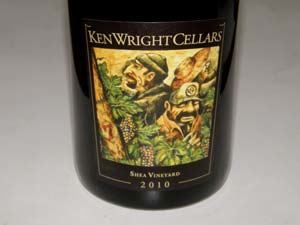 2010 Ken Wright Cellars Shea Vineyard Yamhill-Carlton District Pinot Noir 13.75% alc., $44. · Moderately light reddish-purple color in the glass. Pleasing aromas of black cherries and dark red berries with a hint of vanillin and sandalwood. Reasonably concentrated flavors of dark cherries, berries and currants with a subtle note of oak and herbs. Nicely balanced with supple tannins. This wine is slow to give up its charms. When tasted the following day from a previously opened and re-corked bottle, the aromatics were much more expressive with scents of cherries, spice and cut flowers, and a delicious black cherry core had emerged, offering good intensity and length. Decant if you must drink now. Very good.
2010 Klee Willamette Valley Pinot Noir 13.5% alc., $17. From winemaker Chris Berg of Racine Wine Co. and Roots Wines. · Light reddish-purple color in the glass. Aromas of brandied cherries with a hint of oak. Bright and juicy flavors of strawberries and cherries accented by subtle oak. Light in weight, even a bit shallow, with mild tannins and easy drink ability. Will work fine with summer bbq or lounging by the pool. Decent.
2009 Kramer Vineyards Yamhill-Carlton Brut Sparkling Wine 12.5% alc., pH 3.10, TA 0.90, Residual Sugar 0.3%, 149 cases, $24. 50% Chardonnay and 50% Pinot Noir. · Faint yellow color in the glass with a good bead. Complex nose with an array of scents including green apple, lemon zest, white peach, roasted nuts and dough. Flavors of green apple, lemon and toasted brioche are lifted by bright acidity, and hang on through the long, bone dry finish. Highly enjoyable. Very good.
2010 Kramer Vineyards Estate Yamhill-Carlton District Pinot Noir 13.0% alc., pH 3.70, TA 0.58, 125 cases, $20. From a sustainably farmed estate vineyard, including various clones from several blocks. Winemaker is Trudy J. Kramer. 100% de-stemmed, 10-day cold soak, aged 10 months in 33% new French oak barrels. · Moderately light reddish-purple color in the glass. Love the nose which is fragrant with aromas of exotically spiced black cherries with a hint of toast. Over time in the glass, the scent of cardamom spice and rose petals emerge. Moderately rich essence of black cherries and cranberries with a black tea, tar and citrus note in the background. Has some backbone, but the tannins are ripe and not intrusive. Highly enjoyable now. Very good.
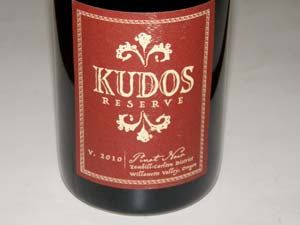 2010 Kudos Reserve Yamhill-Carlton District Willamette Valley Pinot Noir 13.8% alc., $20. From the NW Wine Co. in McMinnville under the direction of Laurent Montalieu. A big seller at Total Wine & More in California. Aged 10 months in oak. · Moderately dark reddishpurple color in the glass. Delicate scent of black cherries and black raspberries with a subtle note of oak. Middleweight flavors echo the nose with a little minerality in the background. Sturdy tannins, yet very soft in the mouth. This wine aims to please now. Good.
2010 Longplay Lia’s Vineyard Chehalem Mountains Willamette Valley Pinot Noir 13.0% alc., $20. Todd Hansen is the grower and Aaron Hess is the winemaker. · Light garnet color in the glass. Scent of cherries and faint oak, picking up intensity and desirability over time in the glass. Light and elegant, with tasty cherry fruit flavor accented with a hint of spice and oak. Very delicate, with gossamer tannins, but delivers some solid flavor. Good.
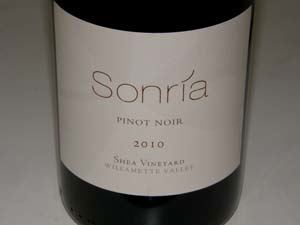 2010 Sonría Shea Vineyard Yamhill-Carlton District Pinot Noir 13.7% alc., $60. · Moderately light reddish-color in the glass. Very pleasant perfume of redfruited tart with a hint of mocha. Smooth, gentle and seamless, with restrained flavors of red fruits, rhubarb and herbs, somewhat buried in tannins at this stage. I like this wine for its lacy restraint and elegance. Should pick up fruit expression over time as the tannins become better integrated. Very Good.
2010 St. Innocent Shea Vineyard Yamhill-Carlton District Pinot Noir 13.5% alc., 922 cases, $36. Yields 2.6 tons per acre. 100% de-stemmed, 2-day cold soak, aged 16 months in 35% new French oak, bottled without fining. · Light reddish-purple color in the glass. Demure aromas of red berries, bramble, spice and oak. Tasty core of dark red cherries, berries and pomegranates, nicely spiced and somewhat savory with complimentary oak in the background. On the lighter side, but displays very charming fruit framed by bright acidity, finishing with noticeable length. Very good.
2010 St. Innocent Temperance Hill Eola-Amity Hills Pinot Noir 13.0% alc., 583 cases, $28. From blocks planted in 1984 and 1995. Yields 1.5 tons per acre. 100% de-stemmed, 2-day cold soak, aged 16 months in 32% new French oak, bottled unfined. · Moderately light reddish-purple color in the glass. Aromas of black cherries and toasty oak. Elegant, yet offering some richness of red fruit flavor underpinned with notes of tea and tarry oak. Round and polished, soft in the mouth, finishing with a dark cherry bonus. Becomes more expressive over time in the glass indicating decanting is beneficial at this early stage. Good (+).
2010 St. Innocent Zenith Vineyard Eola-Amity Hills Pinot Noir 13.5% alc., 704 cases, $30. Clones 777 and 667 from older blocks and young vine Pommard. Yields 1.4 tons per acre. 100% de-stemmed, 2-day cold soak, aged 16 months in 40% new French oak, bottled without fining. · Medium reddish-purple color in the glass. Shy nose initially, opening slowly over time to reveal inviting aromas of black plum, blackberry and subtle oak. Middleweight flavors of dark red and black berries, backed by well-proportioned firm tannins, finishing with a pleasing note of raspberries. Very soft in the mouth with seamless balance. Will benefit from further bottle age. Very Good.
A 2009 vintage addition:
2009 TeBri Vineyards Estate Grown Willamette Valley Pinot Noir 13.9% alc., 390 cases, $20. A family owned and run winery located in the Monroe Hills of the Southern Willamette Valley. · Moderately light reddish-purple color in the glass. Nicely perfumed with scents of black cherries and fresh herbs. Medium weight flavors of dark red cherries and berries with an undertone of savory herbs, finishing crisp with a cherry-driven finish. A solid, easy drinking wine. Good
2009 TeBri Vineyards Select Willamette Valley Pinot Noir 13.9% alc., 110 cases, $36. · Moderately light reddish-purple color in the glass. Striking aromatic power featuring scents of fresh cherries with a hint of baking spice and sandalwood. Good mid palate richness featuring ripe cherries clothed in fine-grain tannins. Very refined, finishing with a cherry flourish. Good (+).
Note: TeBri Estate wine is distributed throughout Oregon and sold at all Markets of Choice and a limited number of Fred Meyers, Roth Supermarkets, and a number of fine wine merchants in Oregon and California. Both the Estate and Select Pinot Noir are available online at Oregon Wine Merchants and Northwest Wines and the wines can be purchased directly from the winery by emailing them at Pinot@tebri.com.
Pinot Noir Blanc: Pure Juice
The pulp and juice of the Pinot Noir grape are nearly clear, and most of the aromas, flavors, and all the color of Pinot Noir comes from the grape’s skins. Pinot Noir Blanc is a white wine produced from Pinot Noir by pressing the grapes after harvesting before any significant skin to juice contact occurs. Depending on the handling of the juice, the resulting dry wine can be lean and crisp or full-bodied and highly flavorful. In either case, Pinot Noir Blanc features primarily white wine flavors: Pinot Noir without the Noir. The wines display a white gold to golden copper color. Pinot Noir Blanc should not be confused with Pinot Blanc which shares the same DNA as Pinot Noir but is a genetic mutation that is a white grape. It is similar to Chardonnay and wineries often vinify it either in stainless steel or oak barrels, with or without malolactic fermentation, like Chardonnay, depending on the stylistic goal. Tony Soter at Etude pioneered Pinot Blanc in California and numerous wineries in Oregon produce exemplary versions. Still another variation of white Pinot is the Bourgogne Pinot Blanc produced by Domaine Henri Gouges in Nuits-St.-Georges. Pinot Noir is known to be prone to mutating, and in Gouges’ vineyard, a separate cultivar emerged over 70 years ago which is a white version of Pinot Noir, but not thought to be the same as Pinot Blanc, although it has been labeled that at times. The French also produce Blanc de Noir from Pinot Noir and Pinot Meunier, but it is a clear sparkling wine. Although now popular in the Willamette Valley, Pinot Noir Blanc was not invented in Oregon. I know of examples produced in California by Joseph Phelps going back to the mid 1970s. Quantities have always been small, and there has never been a large market for Pinot Noir Blanc. None of the common references on wine even mention it. Some consider it a bastardization of Pinot Noir. The emergence and popularity of Pinot Noir Blanc in Oregon arose from several sources. In the cool vintages of 2010 and 2011, some grapes did not reach the full phenolic ripeness desired for Pinot Noir and winemakers found a use for the grapes other than Rosé. The quality of these Pinot Noir Blancs usually reflect the use of less than premium fruit. Other Oregon producers saw an opportunity to compliment their Pinot Noir with a white wine when Chardonnay grapes were not available. Chardonnay has not been particular popular in Oregon, anyway. Any wine with “Pinot Noir” in the name holds interest for the consumer, and like Pinot Noir, the wine is also quite food friendly, pairing well with a wide range of appetizers, salads, charcuterie, cheeses (brie), and white-sauced pasta, and seafood, depending on the style of the wine. Domaine Serene, through its marketing power, brought Pinot Noir Blanc to the attention of the Oregon wine community. Pinot Noir Blanc was a central player in the acrimonious parting of winemaker Anthony Rynders from Domaine Serene in 2009. Domaine Serene began producing a serious Pinot Noir Blanc called Coeur Blanc in 2003 and it quickly caught the interest of consumers. A number of allegations were made by Domaine Serene against Rynders when he chose to leave his position there as winemaker, but the main issue was the winery’s winemaking process used to produce Coeur Blanc from Pinot Noir grapes. Domaine Serene was concerned that Rynders would use the winery’s proprietary winemaking process to make his own competing Pinot Noir Blanc. Rynders argued rightly that the method of making white wine from Pinot Noir grapes is not proprietary and is common knowledge to trained winemakers. The challenge was settled when Rynders agreed not to produce or consult on a Pinot Noir Blanc for three years. Domaine Serene recently released its 2010 Coeur Blanc ($85), which is barrel fermented and made from 100% estate Pinot Noir grapes. The grapes are gently whole-cluster pressed, with minimal contact with the purple grape skins so that the purest essence or “white heart” (the French translation of Coeur Blanc) is expressed. The juice is barrel fermented on the lees in 30% new French oak for 15 months and further aged for a year in bottle.
 My personal favorite Oregon Pinot Noir Blanc is produced at Anne Amie by winemaker Thomas Houseman. Since 2007, he has crafted a superb example labeled “Prismé,” and is his favorite wine among the many he makes. Prisms of course split light into its color components, but Prismé does the reverse. A better name would have been Msirp, but that is plain weird. When asked why he likes this wine so much, he responded as follows. “Pinot Noir Blanc is similar to a full-bodied Pinot Noir that has been stripped of all its wainscoting. It does not hide anything. Its shows its provenance and the hand of the winemaker. It is vintage, vineyard and clone in its purest form, shaped and nurtured by me. It is Pinot Noir without the red.” Anne Amie’s Prismé is not inexpensive ($45) but in the style Houseman prefers, it is challenging to produce. Houseman says, “It is a bit of a beast to make and a nightmarish labor of love.” It requires the same crew and winery equipment as needed to produce premium Pinot Noir. The grapes are carefully sorted as they go into the press. The grapes inside the press have a maximum of five minutes skin contact before the press is emptied. The juice is settled overnight, then racked into French oak puncheons (25% new), when several aromatic yeast strains are used to ferment the juice to dryness. This is a slow process. Once primary fermentation ends, the wine goes through full malolactic fermentation and lees stirring until the richness, viscosity and toasty flavors are achieved. At this point, the wine is racked to neutral barrels and aged on the lees until bottling for a full 18 months.
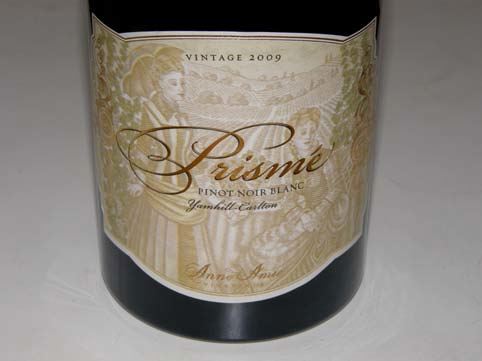 You can have plenty of fun playing with Pinot Noir Blanc for it will challenge your senses. I encourage you to try it. Here is a list of some Oregon Pinot Noir Blancs. Production is small, so the wines are often only sold at the winery.
2009 Anne Amie Prismé Yamhill-Carlton Pinot Noir Blanc $45
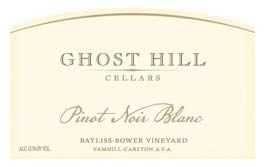 A popular Pinot Noir Blanc from California is the Belle Glos “Oeil de Perdrix” which is labeled a Pinot Noir Blanc but is more a rosé in color and style. The name is derived from the French who call this style of rosé, oeil-deperdrix, or “eye of the partridge.” It is believed to have originated in the Champagne region of France during the Middle Ages to compete with the fuller bodied wines of Burgundy. The wine is a speciality in Switzerland, a dry rosé made from free run juices of Pinot Noir. The French term, Vin gris, is also applicable here. Belle Glos claims that the Wagner family has made this style of wine for more than 35 years. Pinot Noir juice is pressed quickly after it reaches the right level of color, then partially fermented in French oak barrels resulting in a full-bodied rosé style of wine that has both red and white fruit aromas and flavors and is relatively low in alcohol. The source of grapes for this wine has varied, but the current 2011 release is from Sonoma County ($19.99). Like the other Belle Glos Pinot Noirs, the wine has an attractive large dip of wax, pink in this case.
The Cradle of Oregon Pinot Noir
The HillCrest Vineyard winery was bonded in 1963 (Oregon Bonded Winery 44 and the oldest continuously running winery in Oregon), the same year Sommer released his first wine, an estate Riesling. He commercially bottled a Pinot Noir as early as 1967 (and possibly as early as 1964). This was a first for Oregon, and preceded the first Pinot Noir released by David Lett in 1970 at The Eyrie Vineyards and the first commercial Pinot Noir produced by Charles Coury at Charles Coury Vineyards the same year.
 Dyson DeMara, his chef spouse Susan, and their three children, took over HillCrest Vineyard in 2003. Dyson had spent more than 20 years in the California wine industry, had made and taught winemaking in many countries, and had a wealth of wine knowledge, so he was an ideal candidate. He had met Sommer in 1999, and spent time with him both before and after assuming control of the winery. The sale of the winery took some time, for Sommer was reluctant to relinquish his life’s work, despite the urgings of his family. When the winery was finally sold, much of the original plantings were dead, suffering from the fungus Eutypa lata (Eutypa die back disease). DeMara pulled out most of the original 1961 plantings in 2004, including all the Pinot Noir, leaving some Chardonnay, Riesling and Sylvaner. Of the original vines rooted at HillCrest between 1961 and 1968, 13 acres remain, primarily from the 1964 plantings including Oregon’s first commercial plantings of Cabernet Sauvignon. Some Pinot Noir remains from the 1968 plantings. Dyson insists on farming his estate vines sustainably and without irrigation. Purchased grapes are only sourced from vineyards that are at least eight years old. Before this year’s IPNC, I visited Hillcrest Vineyard and spent some enjoyable time with Dyson. He has an outgoing persona and a world of stories to tell, and is especially enthusiastic about his wines. He calls them “honest” wines, because the winery operation is truly family owned and run with no employees. He does not employ any fancy technology and insists on no additions to his wines. Grounded in Old World winemaking, he is nevertheless innovative. He has patented a cement fermentation tank design which is similar in shape to halved stainless milk containers popularized by Williams Selyem in California.
 Dyson is serious about maintaining Sommer’s legacy of producing fine wine. His wines are sold primarily to those in the know in the Umpqua Valley who visit regularly. The wines are only sold through the tasting room which is nearly always staffed by Dyson himself who offers a colorful, guided complimentary tasting. When I approached the old, rustic building housing the winery and tasting room, I did not know what to expect. After talking with him (and he does love to talk) over the copper-covered bar in the tasting room and sampling many wines in his lineup, I can say without reservation that his wines are of character and class. Dyson is in no hurry to release his wines, and he often keeps the red wines in barrel for 2 years or more. Many of the current releases are from the 2004 to 2008 vintages. Limited quantities are held back and offered periodically as library wines. Total production is about 1,500 cases of multiple varietals.
 His Cabernet Franc, Cabernet Sauvignon and Tempranillo were all solid wines. I tasted all three Rieslings, one from the estate’s 1964 original plantings that was off the charts, blessed with so many fascinating aromas and flavors. A Rosè with 10% alcohol and slight carbonation from an unidentified grape (he wouldn’t say) was very refreshing. A Pinot Noir Blanc was typical. A Late Harvest Muscat was among the best of its kind I had ever tasted from Oregon. I was able to taste the 2009 Estate Pinot Noir produced from the original 1968 plantings. This was a wine to savor and contemplate, discreetly but deliciously fruited with accents of spice and pepper. The wine will not be released until early 2013, and I have marked the calendar to insure I get my hands on a few bottles. How often does one get to drink an Oregon Pinot Noir from 40-year-old vines? The HillCrest Vineyard tasting room is open March 1 to December 31, 11:00-5:00 daily or by appointment. The winery is located at 240 Vineyard Lane in Roseburg. Visit the website at www.hillcrestvineyard.com. The following photos show the funky clay Indian heads encircling the outdoor fire pit, the view of the Callahan Mountain Range from the winery, and the entrance to the historic winery.

 There are 25 wineries and 50 to 60 growers in the Umpqua Valley. The largest winery produces 11,000 cases annually. In 2010, the entire Umpqua Valley AVA produced 60,000 cases of wine. 75% of the Pinot Noir production (often cropped at 4 to 5 tons per acre) is sent to northern Willamette Valley wineries who cherish the fruit when vintages are cool and production is diminished in the northern Willamette Valley. Besides HillCrest, other Umpqua Valley wineries offering premium Pinot Noir from low yielding vines include Brandborg Vineyard & Winery, Bradley Vineyards, and River’s Edge. Visit www.umpquavalleywineries.org.
Pinot Briefs
MacPhail Family Wines to Open Tasting Room at Barlow Winemaker James MacPhail announced that the new tasting room will open in early 2013 and will offer vineyard-designated MacPhail Pinot Noir and appellation focused wines from Sequana. The old Barlow Apple Processing Plant in downtown Sebastopol is being repurposed as a gathering of local food and wine artisans. It is a good fit for MacPhail whose family has roots in the coastal agricultural community dating back to the 1800s. Visit MacPhail on the web at www.macphailwines.com, Sequana at www.sequanavineyards.com, and learn more about the Barlow. Aubert Tasting Salon Open The Aubert Wines Tasting Salon, located at 333 Silverado Trail in Calistoga, opened September 4 after extensive remodeling of the former August Briggs winery. (August “Joe” Briggs sold his namesake wine label to a partnership including winemaker Jesse Inman) Aubert customers will have their first opportunity to visit the winery and taste both latest releases and library wines, by appointment. Philip Gift will be the new Retail and Guest Relations Manager. Aubert Wines produces Chardonnay and Pinot Noir from single vineyard sites in the Napa Valley, Carneros and Sonoma Coast appellations. Aubert Wines was founded in 1999 by Mark and Teresa Aubert and started with but one Chardonnay. Now Aubert produces six different single-vineyard Chardonnays and five Pinot Noirs, and owns three estate vineyards in the Napa Valley and Sonoma Coast appellations. The winery website is www.aubertwines.com. French Unhappy With Breathalyzer Law The French government is hoping to decrease alcohol related driving deaths by requiring every driver in the country (even tourists) to have a personal breathalyzer on their person while driving or face a fine of 11 euros. The law goes into effect November 1, 2012. France’s drinking limit of 0.05% blood-alcohol content (0.25% in the breath) already is lower than the United States (0.08%) and is roughly the equivalent of two glasses of table wine. The French, who are not immune from scandal, are claiming the law represents a conflict of interest in the breathalyzer test market. The man who heads the nonprofit road safety association that lobbied Parliament to pass the breathalyzer law is also a parttime employee at Contralco, the only company making certified breathalyzers in France and has up to 90% of France’s breathalyzer market. San Francisco Vintners Market - Harvest Hoopla This event will be held Saturday and Sunday, November 17 and 18, 2012, at Fort Mason Center. About 200 wineries will participate and will be selling their wines direct to the consumer, something many consumers have begged for at walk-around wine tasting events, and the first of its kind wine tasting and buying experience. Consumers can sample the wines on display and buy them on the spot. Wineries throughout California, other regional wineries and international wineries will participate. Visit www.sfvintners6.eventbrite.com for tickets.
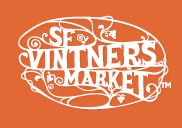
California Increasing Vineyard Acreage From www.norcalwine.com comes the following figures. In the past five years, California added 76,651 acres of wine grape vineyards, an increase of 17.5% from 2006 to 2011. The California counties that added the most acreage were San Joaquin (10,783 acres), Fresno (9,651 acres), Monterey (9,595 acres), Sonoma (8,777 acres) and Napa (7,332 acres). Tiny Marin County saw a 65.8% increase in acreage and now has 167 acres in 2011. Another Pinot Noir producing county, Santa Cruz, has 445 acres as of 2011. Stoller Opens New Tasting Room Stoller Family Estate, at 373-acres, is the largest contiguous vineyard property in the Dundee Hills. Melissa Burr, who has been the winemaker for ten vintages, directs the production of estate-grown Pinot Noir and Chardonnay at three tiers: the legacy tier includes barrel selections honoring Stoller family members, the reserve tier includes the SV Pinot Noir that will become the Reserve Pinot Noir with the 2010 vintage, and the estate tier which features JV Pinot Noir, Chardonnay and Rosé. The grand opening of the new tasting room will be September 10. The tasting room energy will come from a solar panel, and construction features a green roof, skylights, and salvaged timbers from Powell’s Bookstore in Portland. The tasting room will be open daily from 11:00 to 5:00 at 16161 NE McDougall Road in Dayton. Visit www.stollerfamilyestate for more information. Hyland Estates New Label for Venerable Hyland Vineyard Hyland Vineyard is one of the Willamette Valley’s oldest vineyards, first planted in 1971. Located just outside of McMinnville, the current owners are NW Wine Company principals John Niemeyer, Laurent Montalieu and Danielle Andrus Montalieu. The new label, Hyland Estates, was launched in 2011 with the opening of a new tasting room in Dundee on 99W, offering wines from the 2008 and 2009 vintages. Hyland Estates produces Pinot Noir, Riesling and Gewürztraminer. The history of Hyland Vineyard is closely tied to Charles Coury and the Coury Clone (see “Solving The Mystery of the Coury Clone” at www.princeofpinot.com/article/1214/ and Oregon Wine Press (September 2012). Hyland Vineyard now spans 204 acres and is one of the largest single plantings in the northern Willamette Valley. The Hyland Estates brand focuses on the oldest blocks in the vineyard, with winemaker Laurent Montalieu crafting one Pinot Noir solely from old Coury clone vines. A Harvest Celebration will be held at Hyland Estates, 20980 N.E. Niederberger Road, Dundee, on September 29. Visit www.hylandestateswinery.com.
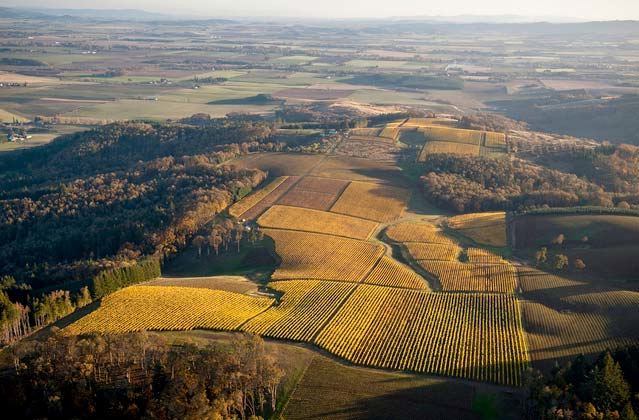 2013 Oregon Wine Press Superior Cellar Awards Announced Oregon Wine Press and the Oregon Wine Board work together to select Oregon restaurant wine lists throughout the United States that feature Oregon wines prominently among their wine list offerings. 63 Oregon restaurants received Superior Cellar Awards in 2013. See the full list of restaurants in the September 2012 issue of Oregon Wine Press.
Race to Review
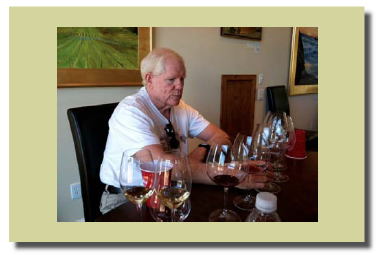 A recent post caught my eye: “45 Seconds to Judge a Wine.” At the Spieglau International Wine Competition at the Marlborough Convention Center in Blenheim, judges evaluating all varietals of wines are served up to 40 wines at a time, and asked to spend 45 seconds to a minute on each wine. It is not unusual for other wine competitions to ask judges to review upwards of 150 wines a day. In February of this year, Steve Heimoff interviewed Antonio Galloni (a wine critic for the Wine Advocate), and posted the results on his blog (www.steveheimoff.com). Galloni said that at home he begins tasting at 8:30-9:00 a.m. and continues to 6:00-7:00 p.m., with “lots of breaks.” He remarked, “When the wines are great, I don’t ever feel tired.” The number of wines tasted was not mentioned, but one must infer there were many tasted each day. Galloni did mention that when he is traveling to a wine region, he probably tastes 100 to 150 wines a day. He commented, “I think tasting wine is a lot like sports. You build up endurance. I don’t ever feel inebriated.” He denied losing any objectivity over these long periods of tasting. My experience has been that some alcohol absorption is inevitable in wine tasting, despite the best efforts to spit out all the wine. The seasoned drinker is more resistant to the effects of alcohol, but judgement will inevitably be impaired if a number of wines are evaluated quickly and an increasing amount of alcohol is gradually absorbed. There are no scientific studies to prove this alcohol-induced loss of credibility, but I believe it occurs. Jancis Robinson, in How to Taste Wine 2008, says, “Even if you carefully spit out every single mouthful, you will probably not escape the effects of alcohol....alcoholic fumes will travel around your mouth, up your nose and retro-nasal passages, and you may feel slightly light-headed. In any case, you will find it extremely difficult not to swallow a single drop of wine.” Robinson estimates that for every 30 wines she tastes and spits, she ingests one glass. Paul Moloney in “Can Wine Tasting as a Profession Damage Your Health?,” (Wine Business Monthly July 2000) states, “In a social setting, about 3% of the alcohol in a drink is absorbed through the tongue and the lining of the mouth before swallowing.” Emile Peynaud, in his classic book The Taste of Wine (1987), remarks, “The passage of alcohol across the mucous membranes of mouth and nose also results in a certain fatigue during extended tasting; even spitting all the wine out will not avoid this effect. The taster should not wait until he is tired before breaking off.” Wine tasting should be a measured, patience exercise, executed in such a fashion as to minimize palate fatigue and imposing inebriation. This is why I taste only 6 to 8 wines daily at home, trying to group the wines with similar alcohol levels, carefully evaluating each wine over a 30 to 60 minute period, trying to minimize the number of spitting passes to remain alert and focused. I plan to carry out future experiments with an accurate breathalyzer to determine how much alcohol is absorbed after spitting out a number of wines in the setting of a normal wine review session. I plan to use really good Pinot Noir. Any volunteers? |
